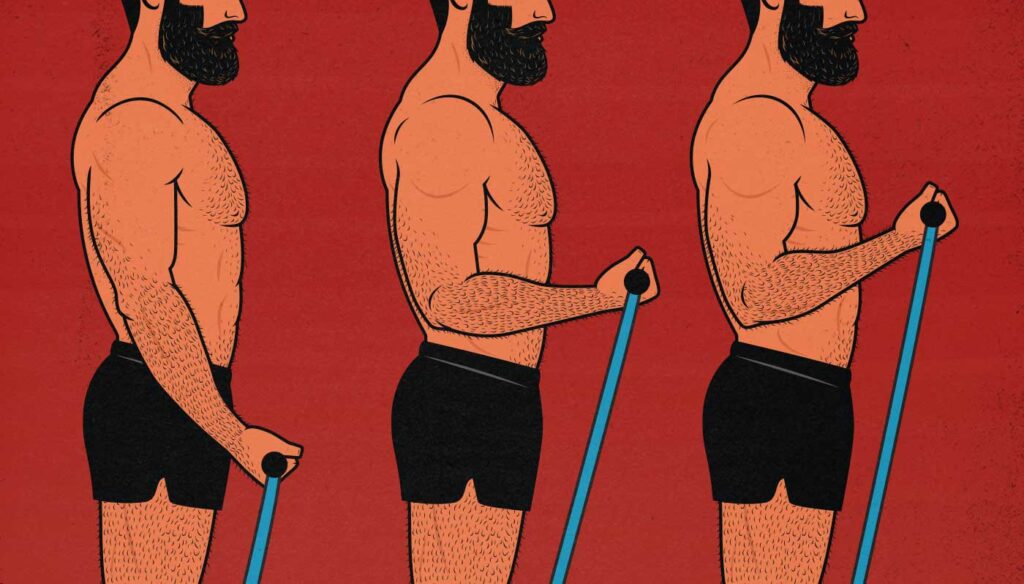
Review of the X3 Bar by Dr John Jaquish: Is It Good for Building Muscle?
Dr John Jaquish is quickly becoming known for making extravagant claims about the benefits of training with his resistance band system, the X3 Bar. According to him, the product that he developed is the very best way to build muscle—three times better than traditional weight lifting. And not only that, it’s cheap, safe, and can be done from the comfort of your very own home.
But is any of that true? Are resistance bands an effective way to stimulate muscle growth? Is the X3 Bar better than the other types of resistance bands? And how does it compare to traditional weight lifting for building muscle? Can it really compete? Does it really offer any advantages?
So, is the X3 Bar good for building muscle? Let’s take a look.
- What is the X3 Bar?
- Does the X3 Bar Build 3X More Muscle?
- Does the X3 Bar Actually Work?
- Is Variable Resistance Good for Building Muscle?
- Are Resistance Bands As Good as Free Weights?
- What About the X3 Exercises & Workout Routine?
- Is the X3 Bar As Good As Weight Training?
- What About Going Beyond Failure?
- What About Keto and Carnivore?
- Can You Gain 20 Pounds of Muscle in 6 Months?
- Summary
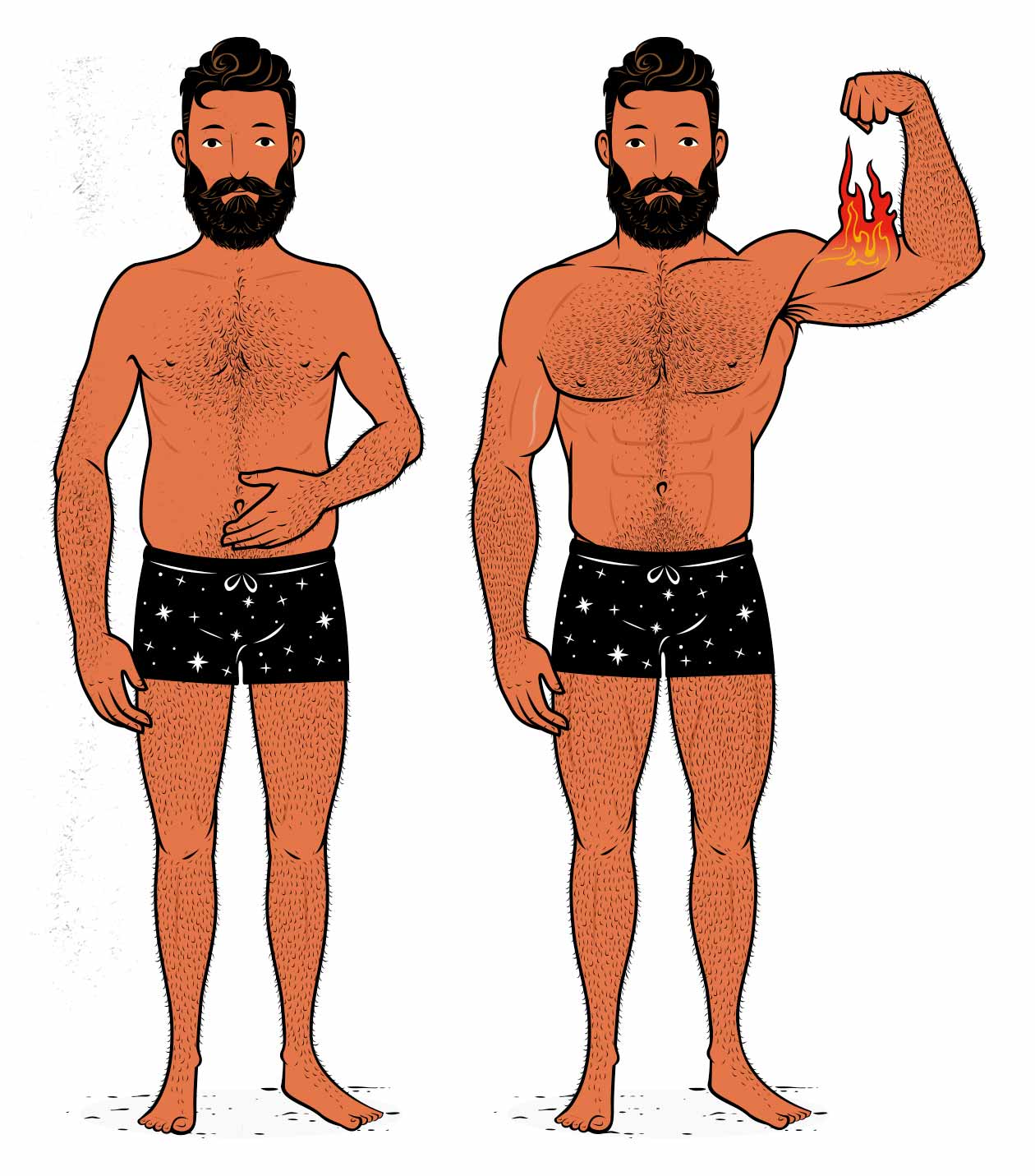
What is the X3 Bar?
The X3 Bar is a bar connected to resistance bands. The resistance bands provide the resistance, the bar gives you something convenient to hold onto. The idea is that because you’re holding a barbell-like handle, you can handle heavier resistance, and so you can stimulate three times more muscle growth, hence the name—X3.
Does the X3 Bar Build 3X More Muscle?
Dr John Jaquish cites this study, The Effects of Combining Elastic and Free Weight Resistance on Strength and Power in Athletes, as proof that the X3 Bar stimulates three times more muscle growth than traditional weight training. Problem is, this study investigated whether we can improve muscle growth by adding band tension to free weights (accommodating resistance), like this:
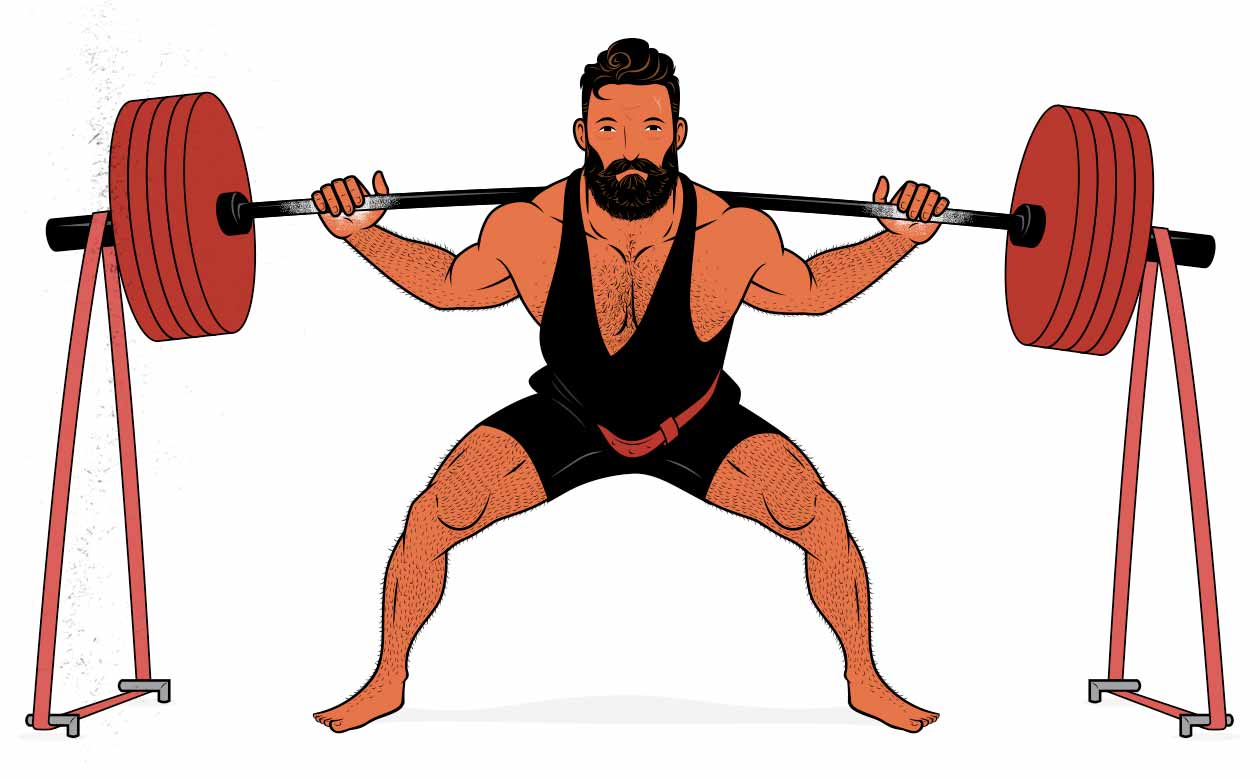
The idea with accommodating resistance is that as we get closer to locking out the weight on some of the big barbell lifts—the squat, bench press, and deadlift—the moment arms get shorter, our leverage improves, and we’re able to lift more weight. So a band is added to the barbell, adding a bit of extra resistance at the top, keeping it challenging throughout the entire range of motion.
Now, this isn’t true with all lifts. If we look at the overhead press, barbell row, chin-up, biceps curl, lateral raise, or a hundred other exercises, the resistance curve is totally different, and so adding a band to the lift wouldn’t help at all. In fact, in some of those cases, we’d want to the opposite, offloading weight as we lift the barbell higher. That’s the idea behind the T-bar row machine. As we lift the weight higher, more of the weight rests on the pivot point, keeping the lift similarly challenging throughout the entire range of motion, like so:
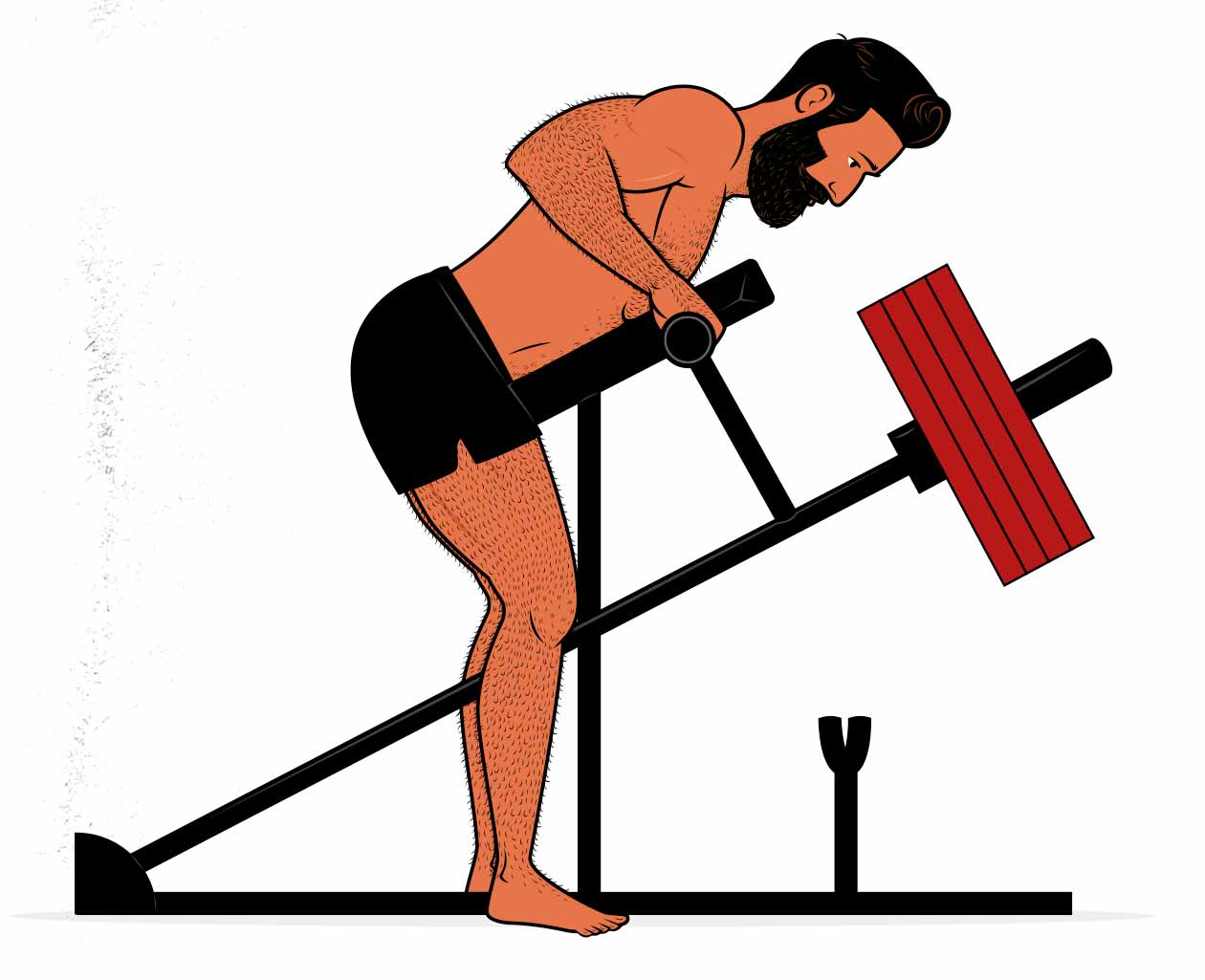
But anyway, that’s not what the X3 Bar does. It doesn’t use accommodating resistance (like weights + bands) and it doesn’t flatten the strength curve (like exercise machines). It gets all of its resistance from resistance bands. This is a type of resistance called variable resistance, where the lift gets progressively harder through the range of motion. We’ll cover the implications of that in a moment.
Where this gets even more controversial is that the study being referenced to show the benefits of the X3 Bar didn’t even find a benefit to adding resistance bands to traditional weight training lifts. The study concluded, “While lean body mass was not significantly different between groups, both groups did significantly increase their lean body mass over the course of the study.”
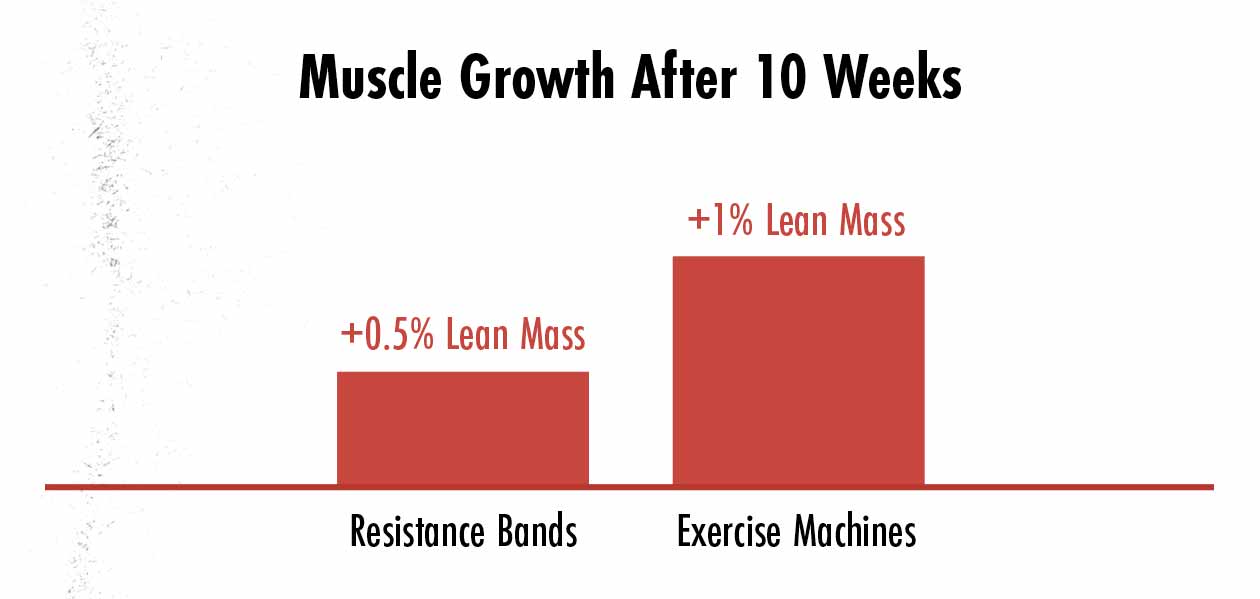
Dr Jaquish does cite one study that used resistance bands, though. It took a group of sedentary middle-aged women and compared their muscle growth after 10 weeks of either using resistance bands or exercise machines. The problem is, again, the study failed to prove that there was any benefit to using resistance bands over exercise machines. The women using the exercise machines gained twice as much lean mass and lost twice as much fat, but the results didn’t reach statistical significance, and so we can’t draw any conclusions.
With that said, none of this proves that the X3 Bar is a scam or that we’ve debunked its effectiveness, just that the studies being referenced don’t back up the claims being made. Even if the X3 Bar doesn’t build muscle three times faster than free weights or exercise machines, maybe it still works comparably well. For many people, that would be enough.
Does the X3 Bar Actually Work?
If we challenge the strength of our muscles, we can provoke muscle growth. This is true whether we use bodyweight exercises, dumbbells, barbells, exercise machines, or resistance bands. All of them put mechanical tension on our muscles, and all of them can build muscle. And that includes the X3 Bar. It’s a legitimate type of resistance training. You can indeed build muscle with it.
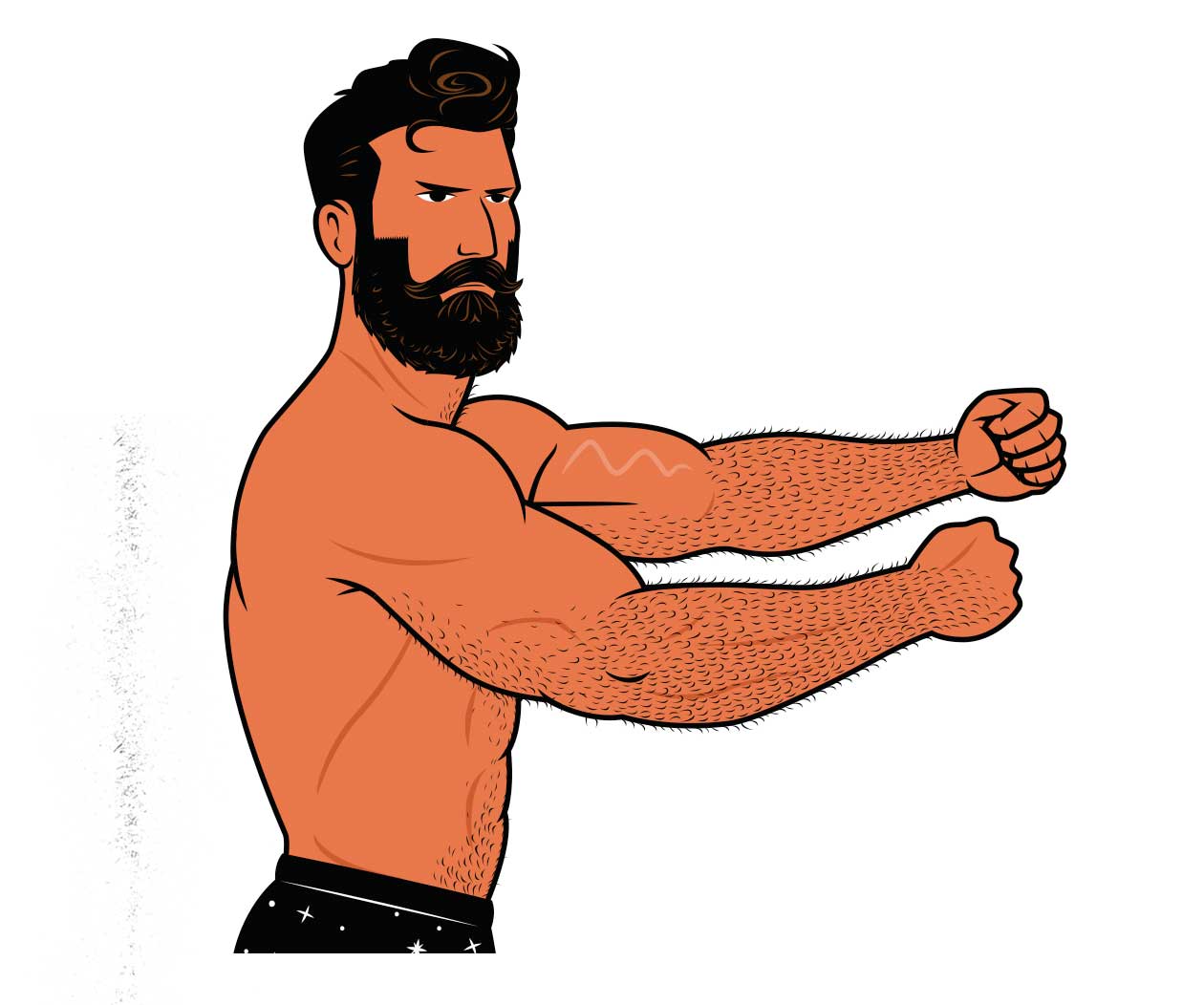
With that said, just because something works, that doesn’t mean that all the claims made about it are true. It also doesn’t mean that it’s the best way to build muscle. It doesn’t even mean that the X3 bar is a good way to build muscle. So let’s dig a little deeper.
Is Variable Resistance Good for Building Muscle?
If you want an in-depth review of the research, we’ve written an entire article on the effectiveness of resistance bands. But I can summarize the main points here, as well as give the recommendations from the top muscle hypertrophy researchers.
What makes the X3 Bar unique from free weights and exercise machines is that it gets its resistance from resistance bands. This matters because as you stretch the band out, the tension increases, providing gradually more resistance as you go through the range of motion. This is called variable resistance, like so:
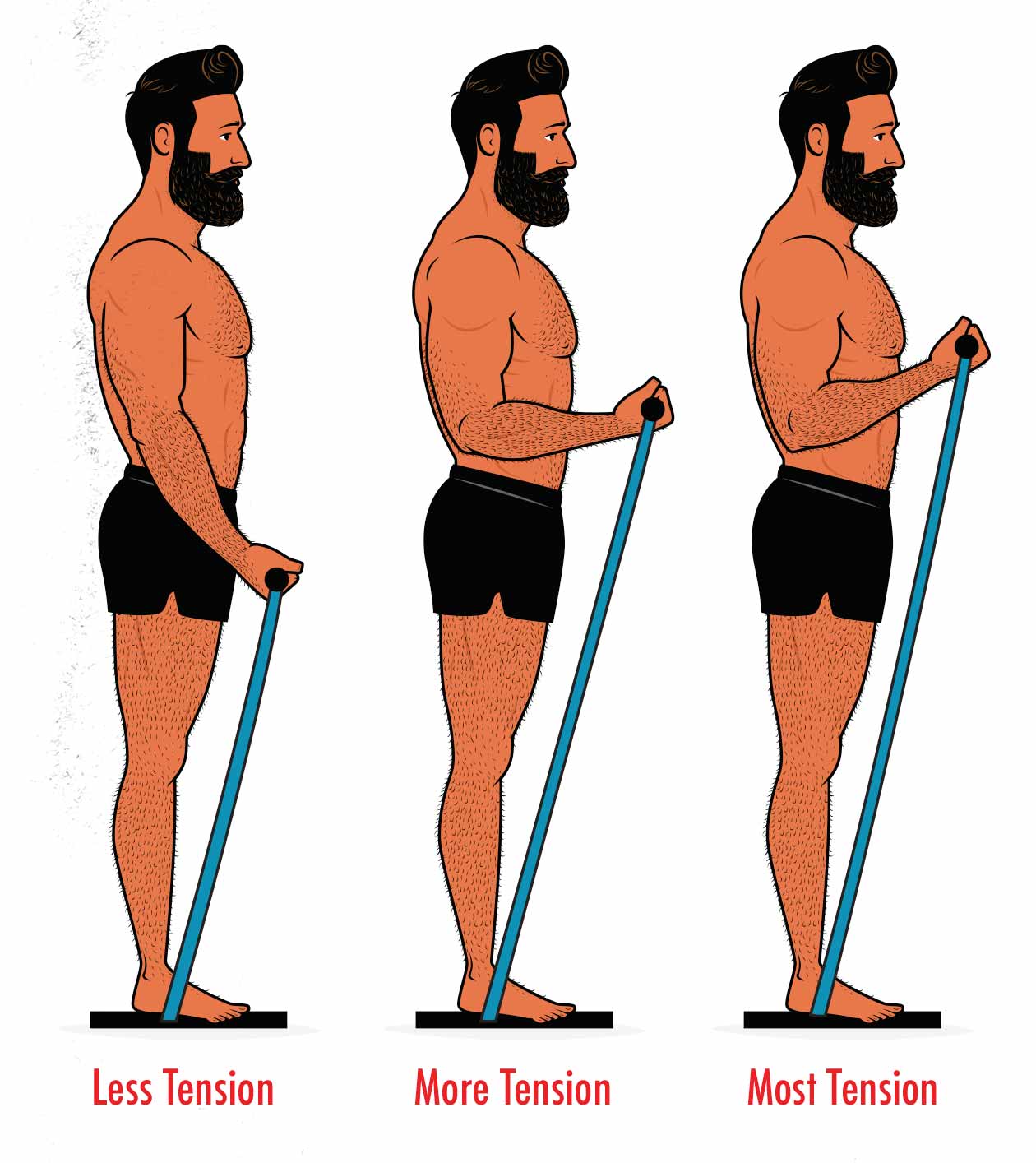
Thing is, there’s a growing body of evidence that when we challenge our muscles at longer muscle lengths, we stimulate more muscle growth. And the effects are quite dramatic, too. If we look at a systematic review of 26 studies, we see that challenging our muscles at longer muscle lengths stimulates almost three times as much muscle growth:
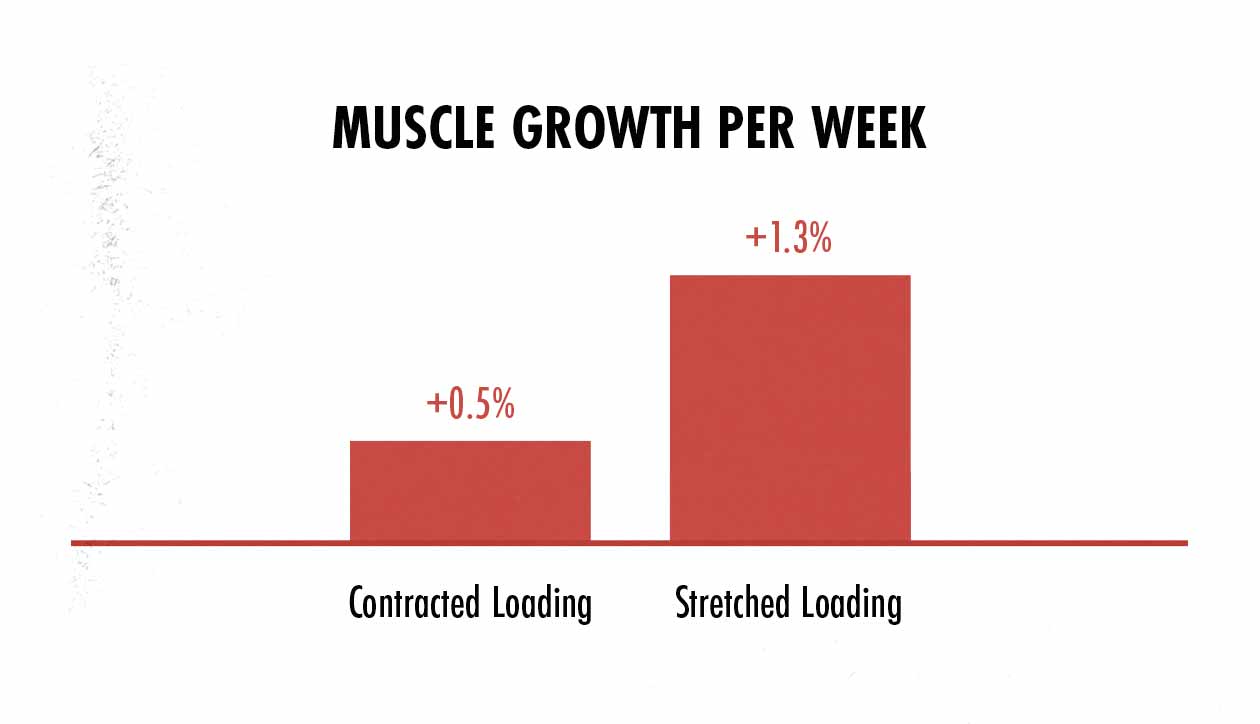
Now, just to be clear, these 26 studies were done using isometric lifts. What that means is that they had some people pulling against an immovable object with their muscles in a stretched position, other people pulling against an immovable object with their muscles in a more contracted position. It’s not comparing lifts with different strength curves, it’s comparing the effects of challenging our muscles at different muscle lengths. (And again, note that even with the worst way of training, challenging their muscles in a fully contracted positions with isometric lifts, the participants were still able to gain muscle.)
So, what we see with this research is that the more stress we put on our muscles when they’re stretched, the more muscle we build. This seems to apply to traditional weight training and exercise machine lifts, too. For example, if we look at a study on hamstring curls, we see that training the hamstrings at longer muscle lengths produced a more than twice as much muscle growth as training them at shorter muscle lengths.
What does this have to do with resistance bands? Resistance bands put a lower amount of tension on our muscles when they’re at longer muscle lengths and a higher amount of tension on our muscles when they’re at shorter muscle lengths. That means that we tend to be limited by our strength when our muscles are contracted, not when they’re stretched. That’s the opposite of what we want. It’s the least beneficial resistance curve for building muscle.
Finally, there’s the claim that “X3 uses variable resistance, which effectively lowers the resistance during the lifter’s weakest range of the lift and increases it during the stronger portion.” For some lifts, such as the bench press, this is true, which is why accommodating resistance is sometimes used. For other lifts, such as the row, this is not, which is why t-bar rows are so popular. It really depends on the resistance curve of the lift. And in either case, the research still suggests that there’s a benefit to loading our muscles heavier at longer muscle lengths.
Where this gets confusing is that challenging our muscles at short lengths tends to result in higher electromyography (EMG) readings. The muscles bunch up, so more muscle mass is under the electrode, so the reading comes out higher. This is one of the problems with EMG research, and it’s why it pays to look at actual muscle growth instead of just muscle activation.
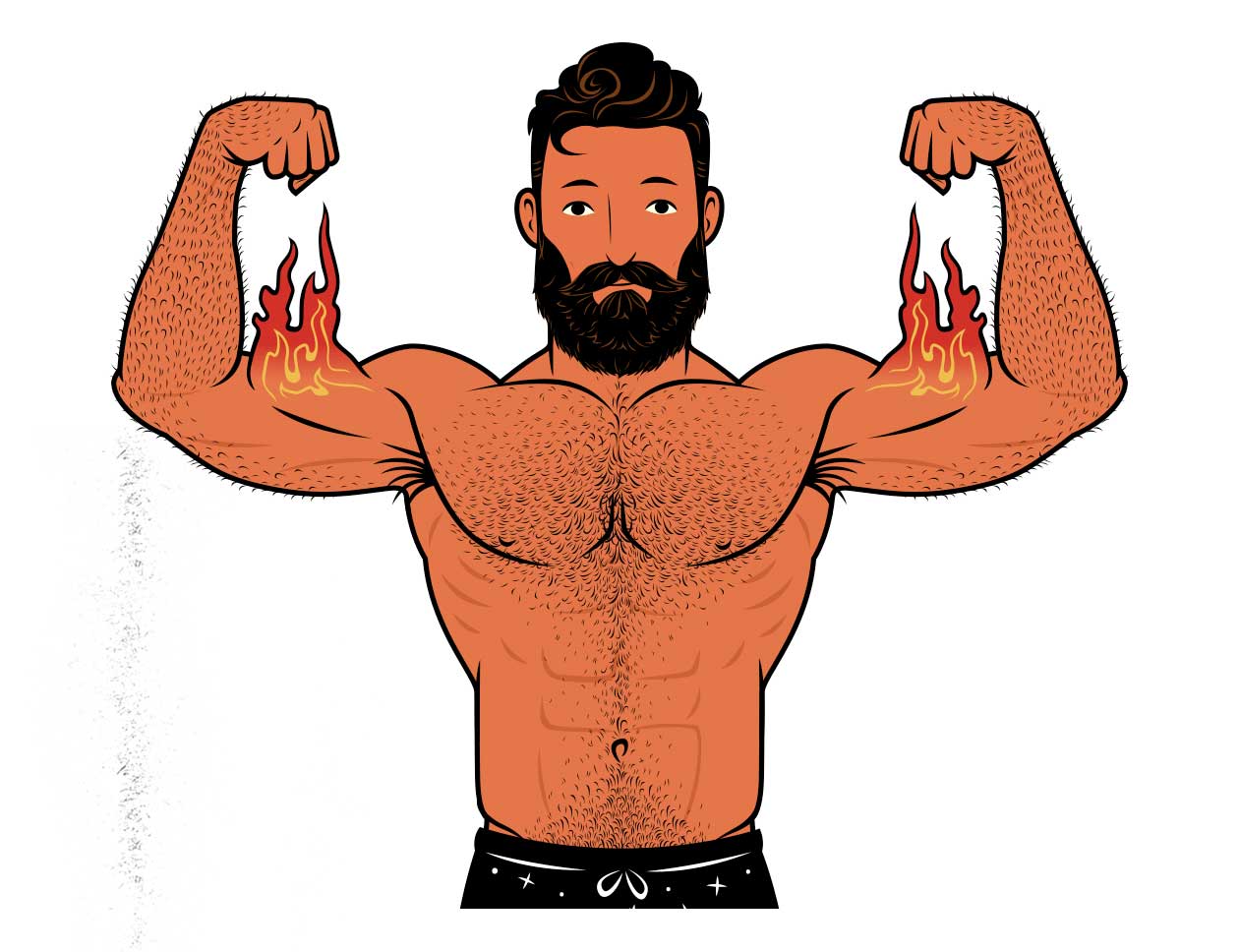
This style of high-rep, constant tension training also tends to give people a killer pump, it often feels quite hard, and it can lead to plenty of muscle soreness. It’s not ideal for building muscle, but it still feels like a rigorous way of training, and so a lot of people really enjoy it. And that’s fine. People should train however they want. But most research shows that we build more muscle by emphasizing mechanical tension, not by emphasizing the pump and burn.
Are Resistance Bands As Good as Free Weights?
So far, my hunch is that free weights and exercise machines are better for building muscle, but maybe I’m missing something. So I talked with one of the top experts in the world, Dr Eric Helms.
Not a lot of research on the topic, but I would agree with your general recommendations of free weights and machines for hypertrophy, with bands and bodyweight working in a pinch.
Dr Eric Helms, PhD
You may be familiar with Dr Helms already. He’s published several important studies looking into muscle hypertrophy, such as this one. He also the co-author of the Muscle & Strength Pyramids, which has been praised by other top hypertrophy researchers, such as Dr Brad Schoenfeld and James Krieger, MSc.
For another perspective, I asked Greg Nuckols, MA. Greg is the founder of Stronger by Science, he’s the creator of the research review, Monthly Applications in Strength Sport (MASS), and he’s the guy who turned me onto the research showing that our muscles grow better when we challenge them at longer muscle lengths.
Yeah, I do think, in general, bands are probably slightly worse for growth since it’s a lot harder to load a muscle at long muscle lengths.
Greg Nuckols, MA
Is any of this conclusive evidence that free weights are better than resistance bands for building muscle? No. That evidence doesn’t exist. But what’s abundantly clear is that there’s no reason to suspect that resistance bands are better for building muscle. In fact, most research suggests and most experts suspect that the opposite is true.
What About the X3 Exercises & Workout Routine?
Every exercise is a little bit different, and the X3 bar will be better at some than others. And just to be clear, this isn’t a horrible way to train. This is resistance training. It will build muscle. But if we look at a lot of these exercises, because of the variable resistance, the range of motion gets really short, and it’s typically the bottom part that gets cut off.

For example, if we look at the X3 chest press, we see that they’re using a very narrow grip (which is bad for the chest) and a shallow range of motion (which is really bad for the chest). To build a bigger chest, better to do the opposite of this, using a wider grip and bringing the barbell all the way down to the chest. That way the chest is trained under a deep stretch, stimulating something like twice as much muscle growth.
But again, if we look at the research comparing training at longer vs shorter muscle lengths, it doesn’t show that it’s impossible to build muscle by training at shorter muscle lengths, just slower. So if all you have is an X3 Bar, that’s okay, just be patient with it. You can still build muscle.
Is the X3 Bar As Good As Weight Training?
So, overall, we have a large body of evidence showing that loading our muscles heavier in a stretched position can stimulate 2–3x more muscle growth than loading them when contracted. This suggests that free weights are better for building muscle than resistance bands, although there’s no research looking at it directly. We also have the top hypertrophy researchers and reviewers suspecting that resistance bands are worse for building muscle.
What does this mean for the X3 Bar? Well, the X3 Bar is a metal bar connected to resistance bands. It’s a slightly more convenient way to use resistance bands. And just like resistance bands, we can indeed use it to build muscle. But because of the variable resistance, I’m doubtful that it can build muscle as effectively as using dumbbells, barbells, or exercise machines.
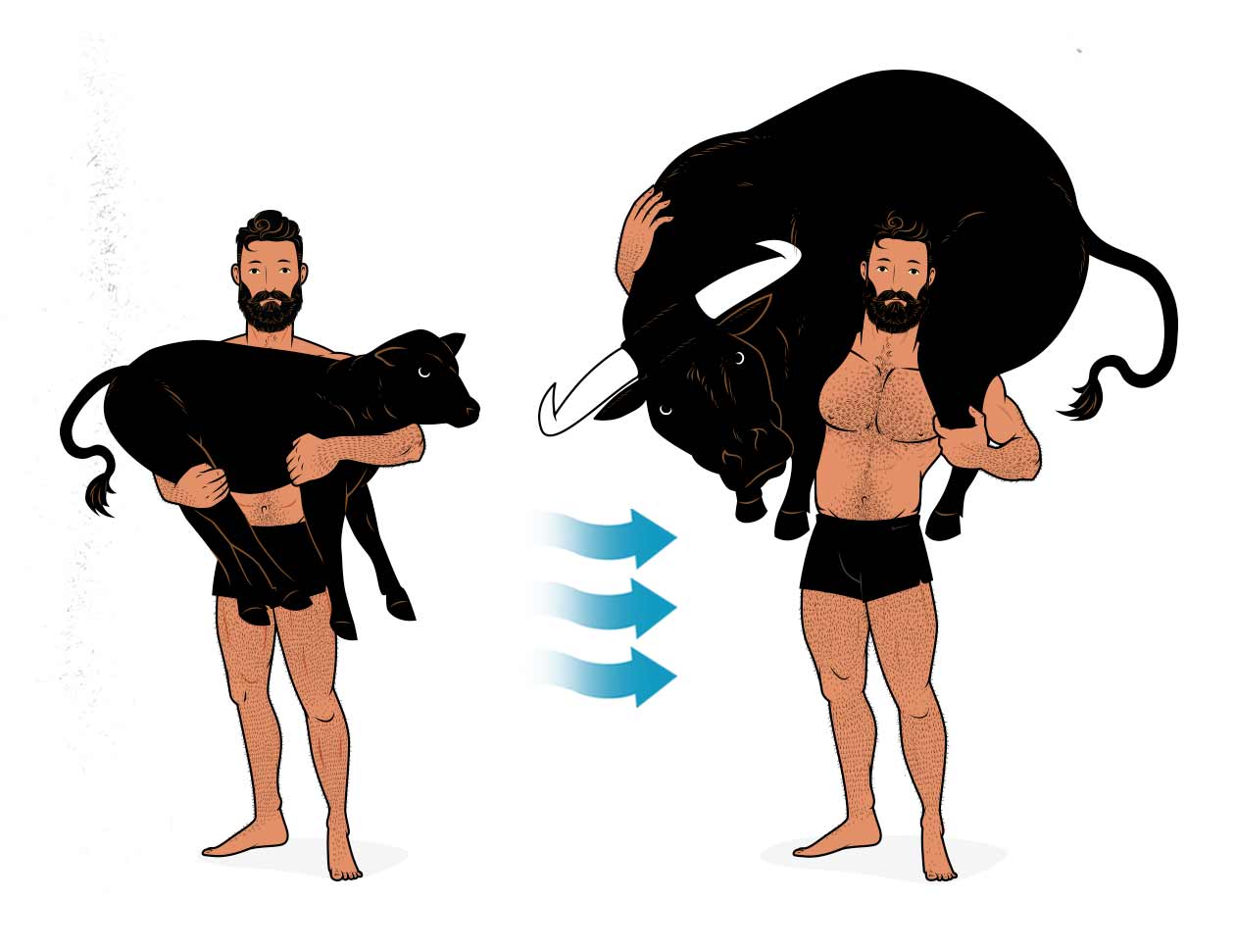
I’d also argue that barbell and dumbbell training is actually quite easy and convenient. We’re lifting real objects, which feels quite natural and intuitive. Weights have a resistance curve that we’ve evolved to be good at lifting. And it’s easy to load those weights gradually heavier, adding tiny little weight plates to the bar over time. That doesn’t mean that free weights are necessarily ideal, but so far nothing has proven to be significantly better.
If you don’t have the money or the space for a barbell home gym, you can always get a couple of adjustable dumbbells that you can hide under your bed or stick in the closet. That’s how I would train when I lived in a small condo. There isn’t really a problem that needs solving. Except, perhaps, for the fact that free weights are so popular right now that they’re sold out everywhere.
What About Going Beyond Failure?
There’s more to the X3 Bar than getting the resistance from resistance bands. For example, one of the other ideas is to keep lifting long past the point of muscle failure. When you can’t complete a full rep, you do half a rep. When you can’t complete half a rep, you do a quarter rep. And so on. You keep pushing until you can’t stretch the band at all.
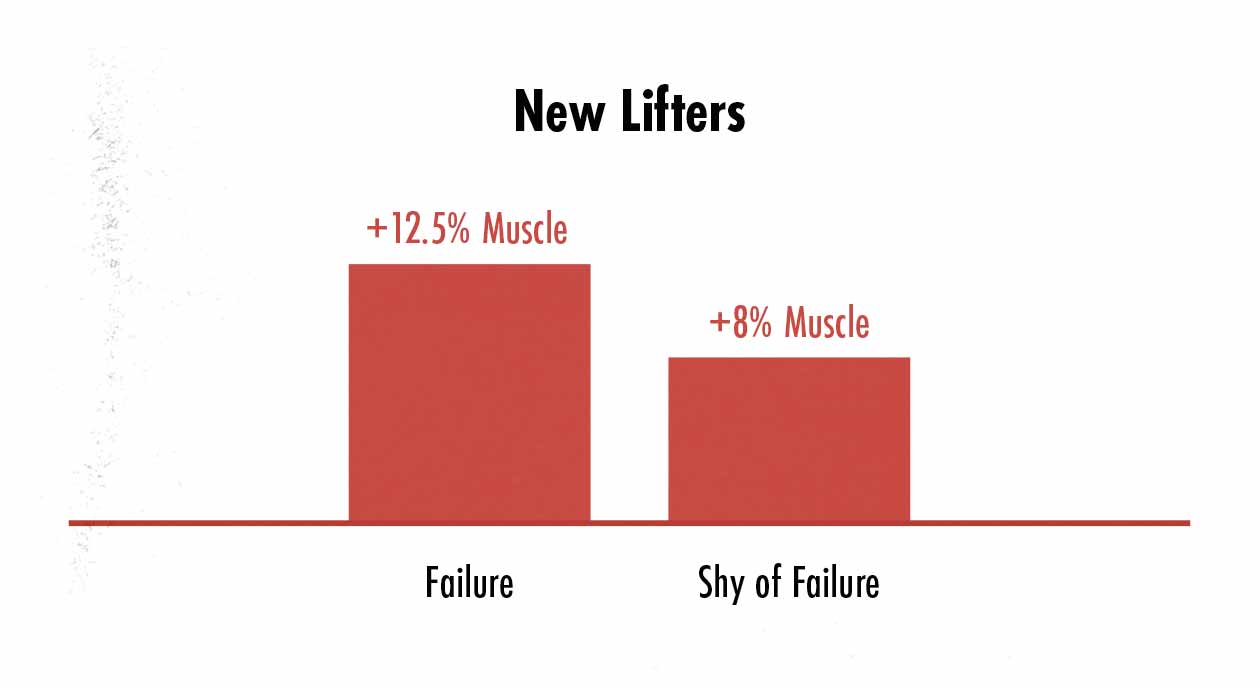
The idea is that by going beyond failure, we do a better job of thrashing our muscles, and so we can stimulate more muscle growth. So far, the evidence points in the other direction. As beginners, we can build more muscle by pushing ourselves as little harder (study, study, study, study), but then as intermediate lifters, it helps to stop our sets shy of failure (study, study, study, study, study).
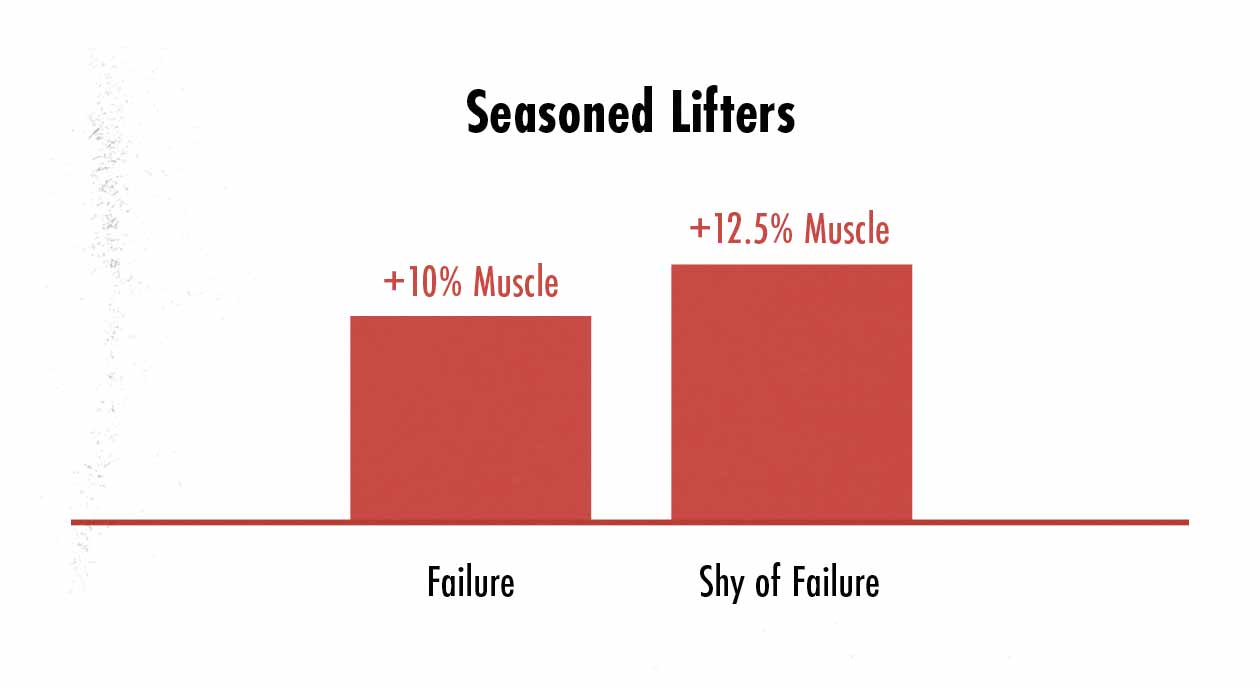
Now, there’s a bit of nuance here. Different lifts are hardest at different parts of the range of motion, meaning that training to failure can look quite different depending on which lift you’re doing. With a bench press, the lift gets a little easier towards the lockout. People are more likely to fail with the bar close to their chests. So with a bench press, when you’re done, you’re done.
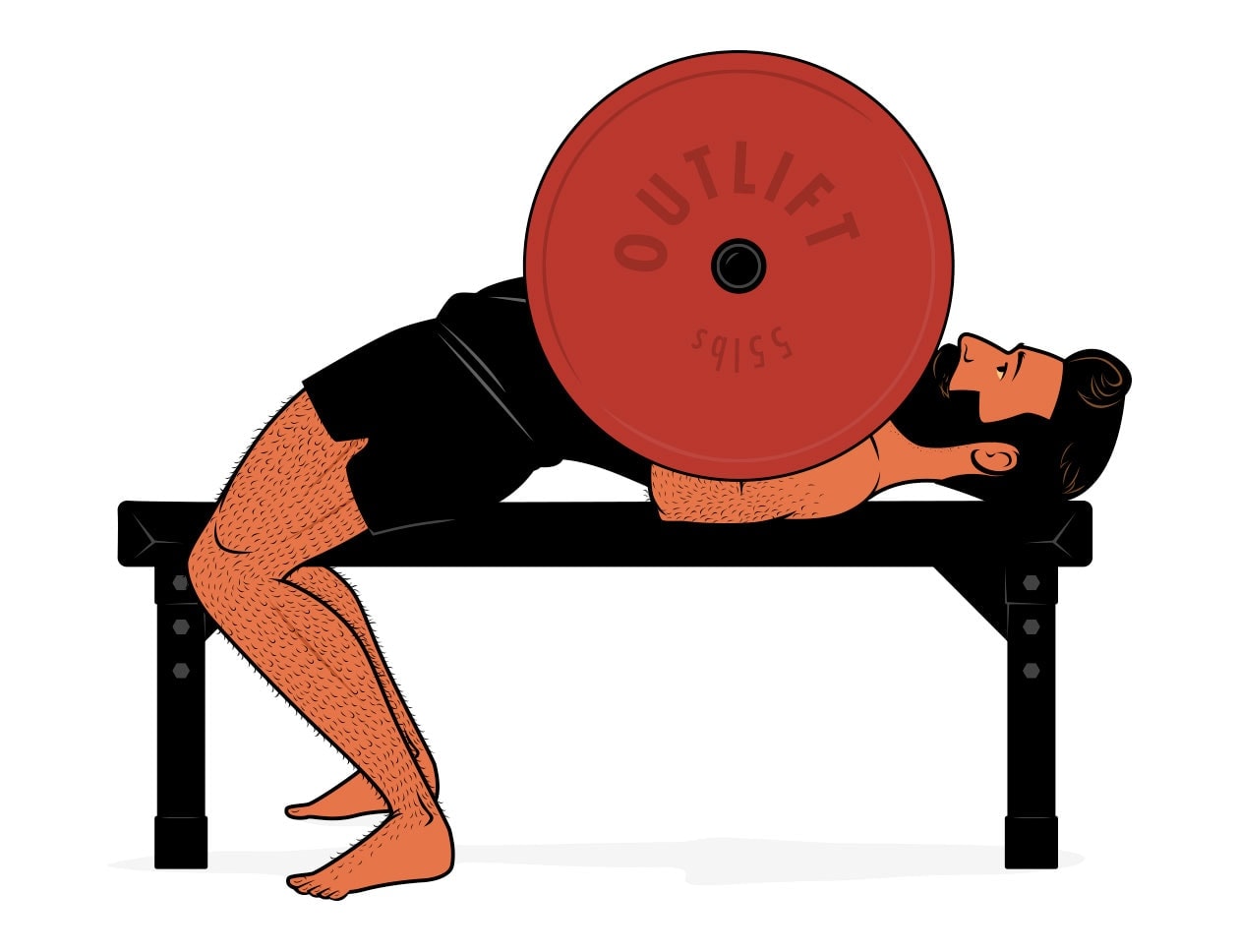
With other lifts, such as the barbell row, the lifts get harder at the top of the range of motion. People are more likely to fail to bring the barbell all the way up to their torsos. So it’s totally possible to do what Dr John Jaquish is recommending, where you keep lifting with a progressively smaller range of motion until you can’t lift the barbell at all.

But is that a better way to build muscle? Probably not. Going past failure is hardly ever recommended, and there’s no evidence to suggest that it stimulates more muscle growth. That isn’t to say that it’s necessarily a bad way to train under all circumstances, just that there’s no reason to think that it would give you a marked advantage.
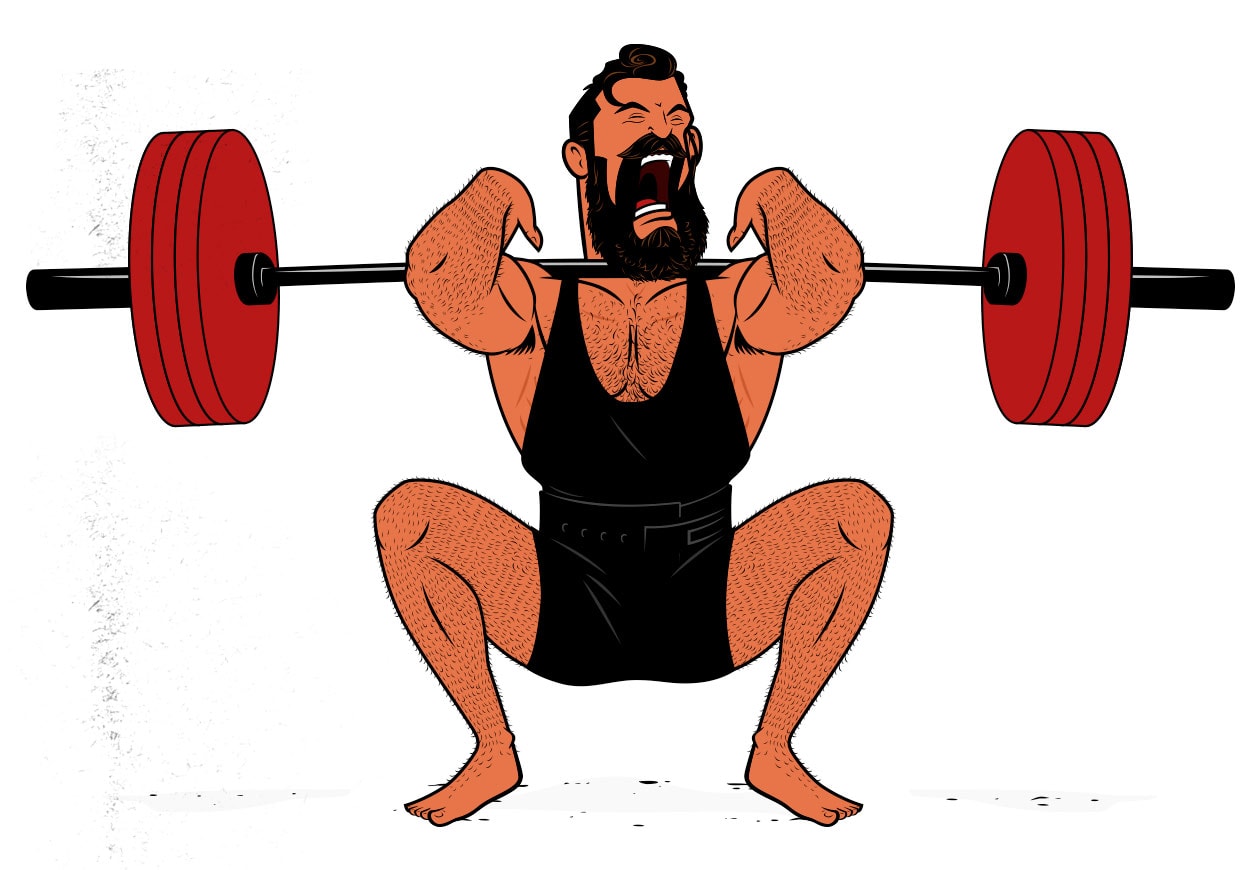
So, if you can, it’s probably best to choose lifts that allow you to lift through a deep range of motion and that challenge your muscles at long muscle lengths with a good resistance curve. Think of lifts like a deep front squat, a bench press, a deficit push-up, a Romanian deadlift. And then stop 0–3 reps shy of failure. That seems to be ideal for stimulating muscle growth.
What About Keto and Carnivore?
The X3 Bar isn’t just a resistance training tool, it also includes a workout routine and a diet. It recommends a meat-based ketogenic diet with minimal carbohydrates, as popularized by the orthopedic surgeon, Shawn Baker. Again, this flies in the face of most research, which shows a strong and clear benefit to the consumption of carbohydrates for building muscle.
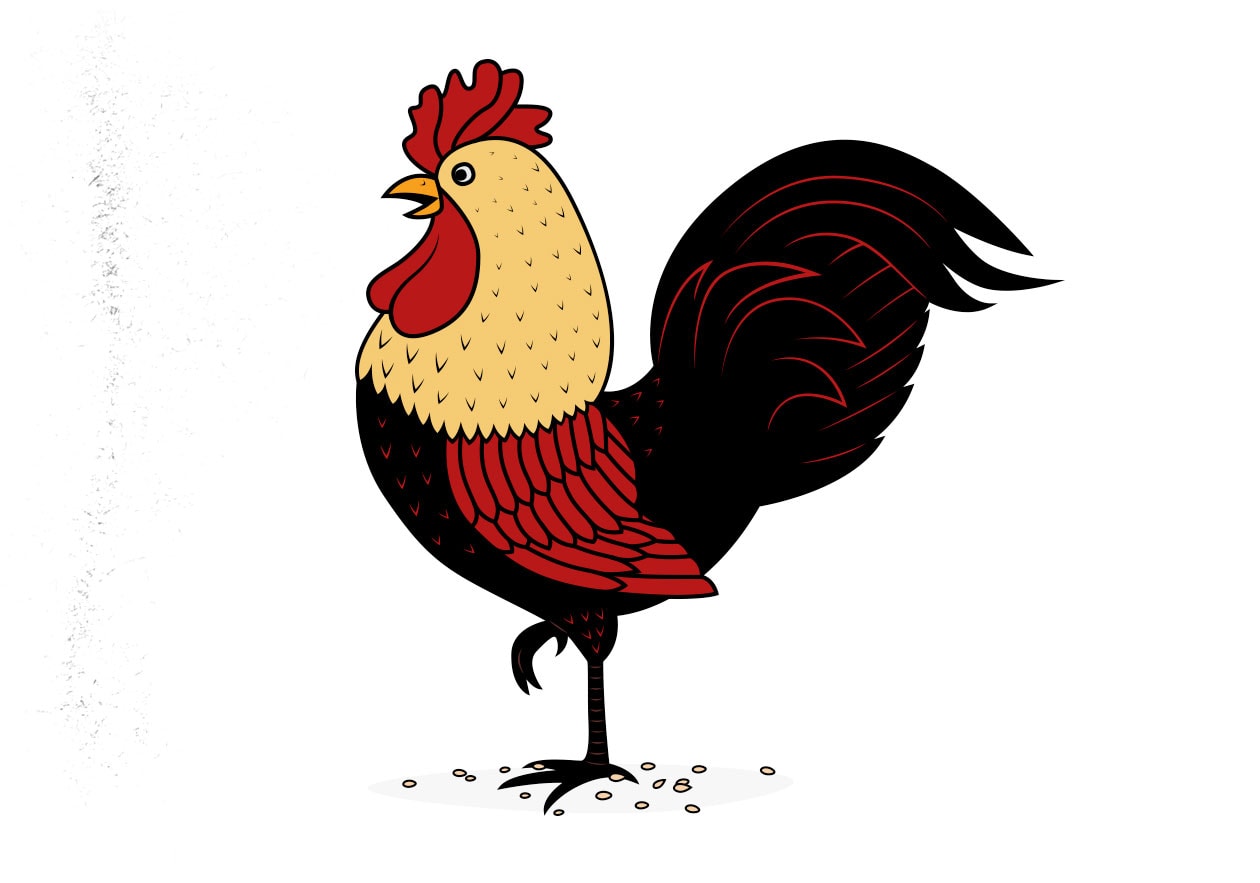
The Journal of the International Society of Sports Nutrition recommends getting 40–60% of our calories come from carbohydrates for gaining muscle mass and strength. The National Strength & Conditioning association recommends getting 45–65% of our calories from carbohydrates to improve our health, gain muscle, and increase our strength. These recommendations also line up with muscle-building research that compare different macronutrient intakes (study, study). And if we look at expert recommendations from researchers like Dr Eric Helms, he recommends getting around 50% of our calories from carbohydrates.

Now, how much does this matter? It’s hard to say. The higher-quality studies looking into the effects of the keto diet on muscle growth, such as this one (shown above), tend to find an advantage to eating more carbohydrates. But it’s not quite that simple. Part of the advantage is that it’s easier to eat more calories when eating more carbohydrates. That’s why other studies, such as this one and this one found that when athletes started eating a keto diet, they stopped gaining muscle mass. But even if we factor out energy intake, carbohydrates still appear to speed up our rate of muscle growth.
The reason that carbohydrates help is because our muscles prefer to run on a fuel called glycogen, which is made out of glucose, which typically comes from the carbs we eat. So the more carbs we eat, the more glycogen we store in our muscles (study, study), and the better our workout performance gets (study). But what’s especially interesting is that having higher levels of glycogen in our muscles seems to boost our rate of muscle growth (study, study, study).
But again, just to be sure, I asked the hypertrophy researcher Dr Eric Trexler, who specializes in muscle-building nutrition and supplementation, what he thought about the pros and cons of using keto for building muscle:
The current evidence doesn’t suggest that it’s impossible to gain muscle on a ketogenic diet, but its effects on appetite and high-intensity exercise performance make it hard to view keto as the ideal dietary approach for gaining muscle.
Eric Trexler, PhD
If you want a more in-depth review of all the relevant research, we have a full article about using keto for muscle growth. But the point is, similar to training with variable resistance, it’s not that eating a ketogenic diet can’t work, it’s just that there’s no evidence showing an advantage, and quite a bit of evidence pointing towards at least a slight disadvantage.
Can You Gain 20 Pounds of Muscle in 6 Months?
One of the criticisms that Dr John Jaquish often comes up against is his claim that when people start using the X3 Bar, they can gain 20 pounds of muscle in 6 months. I actually don’t see a huge problem with that, especially if we’re talking about it more casually, and especially if we’re talking about people who are still relatively far away from their genetic potential.
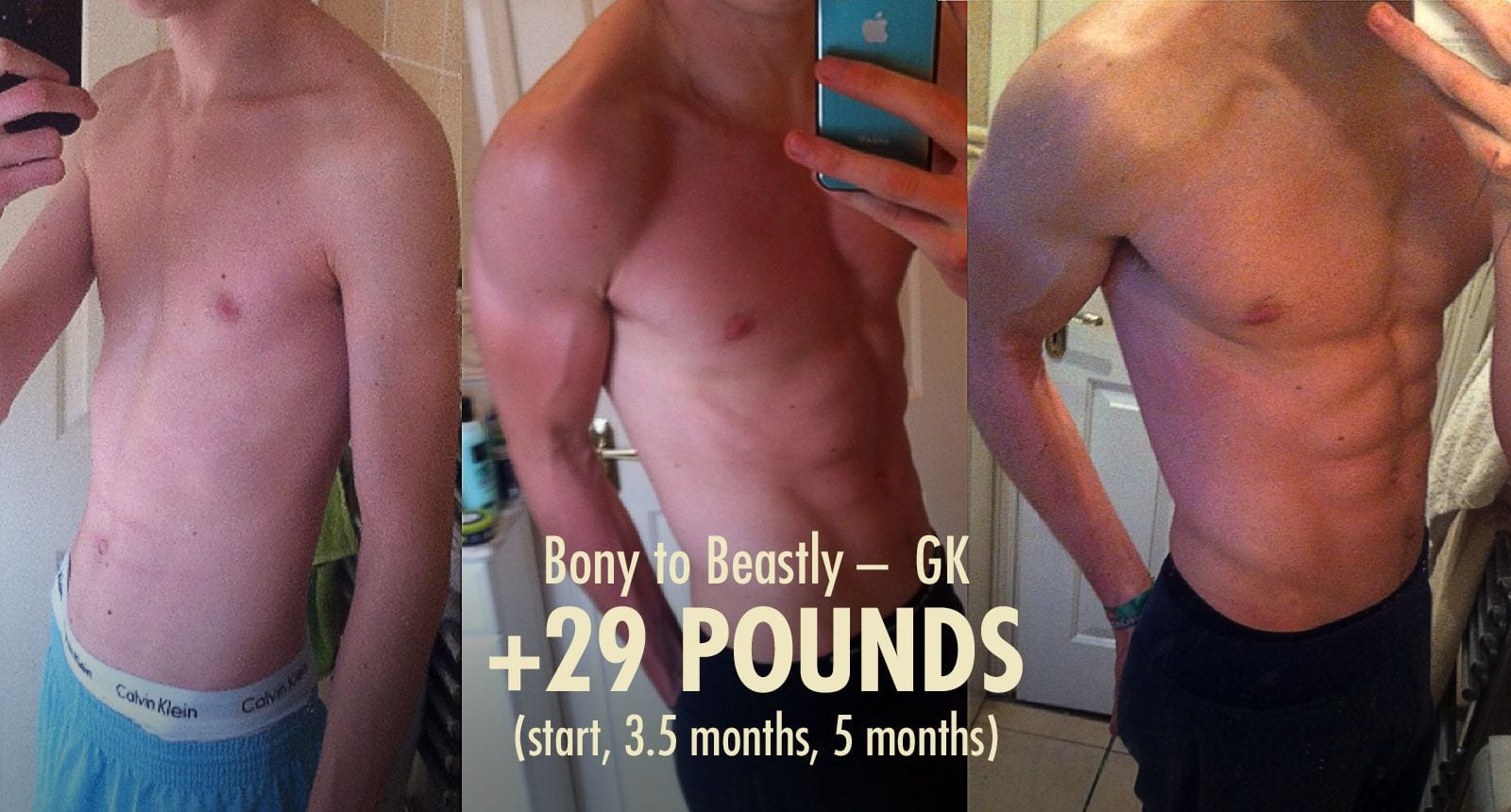
For example, here’s a before and after photo showing that one of the members of our Bony to Beastly Program was able to gain 29 pounds on the scale within 5 months. Is all of that weight muscle? No. His muscles are storing more glycogen, he’s got more food in his stomach, he’s surely gained some fat, his bones are getting denser, and so on. There are many factors contributing to his weight gain. But when people see this, it’s common for them to say that he gained 29 pounds “of muscle.” It’s not true, but it looks true, and it’s just a casual way of talking about his results. I think that’s fine.
The other aspect of this is that when someone is fairly thin, they’re typically able to gain muscle at a much faster rate than someone who’s already near their genetic potential. This is why you’ll see guys gaining 20+ pounds of seemingly lean mass during their first year of weight lifting, but fast forward a few more years, and they’d be lucky to gain 5 pounds of muscle in a year. It all depends on how close to your genetic muscular potential you are.
So is it possible that someone can gain 20 pounds of what appears to be muscle when they start training with the X3 Bar? Maybe! That’s not realistic for everyone, and I’d guess that’s not the norm, but I’m sure it happens from time to time.
Summary
The central claim behind the X3 Bar is that it builds muscle three times faster than traditional weight training. Here’s the evidence behind that claim: study found that adding resistance bands to barbell training did not build more muscle than barbell training alone. I feel like this must be some sort of mistake. The research isn’t on a training method that’s similar to X3, and it didn’t find a muscle-building benefit.
Plus, if we look at the overall body of research on accommodating resistance for gaining strength, the meta-analysis that had found a benefit was retracted. When the mistakes were corrected, no benefit was found. So even when using a hypothetically optimal mix of weight training and resistance bands, the addition of variable resistance didn’t help in any measurable way.
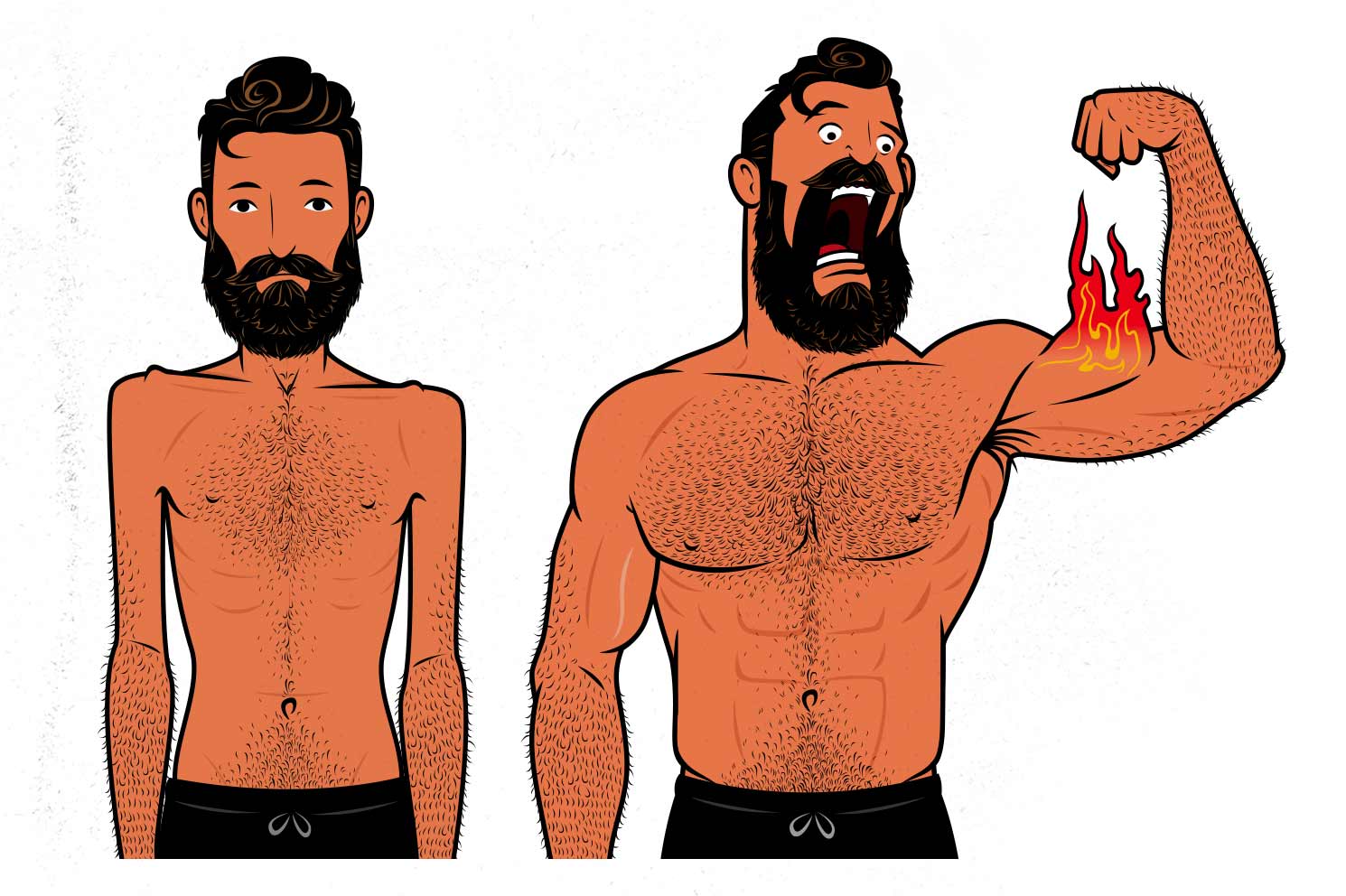
When we’re talking about only using resistance bands, the situation changes. When we stretch out resistance bands, they apply progressively more tension, which is called variable resistance. This is the opposite of what we want when building muscle. After all, we have several dozen studies showing that challenging our muscles at longer muscle lengths stimulates quite a bit more muscle growth. That means that it’s better to load our muscles heavier at the bottom of the range of the range of motion (as with free-weight squats, bench presses, and deadlifts) or with a flat resistance curve (as with exercise machines like the t-bar row).
Still, there isn’t much, if any, research comparing resistance bands against free weights. With the evidence available, there’s good reason to infer that free weights and exercise machines are probably better for building muscle. And this is a position shared by the top hypertrophy researchers and experts in the world. So our argument isn’t that resistance bands are bad for building muscle, just that these claims that they’re better for building muscle are misleading.
Resistance bands have been around for over 120 years, and they’re cheap, convenient, and heavily marketed. They’ve never managed to fully catch on, but some people prefer them, and that’s totally fine. Resistance bands do provide resistance, and X3 is no exception. The claims are wild and unsubstantiated, but you can still build muscle with bands.



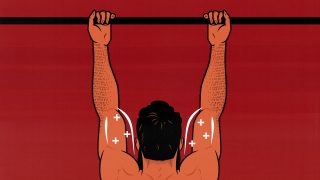



I was using bands with a band-bar from Amazon (not X3 bar but similar principle) in early 2020 for rehab. My weight gain was completely stalled, despite going up to 3500 kcal. Then I switched to your War Chest program, and gained 10 lbs, with 1 lb / week for the first month.
What’s interesting is that I was on the carnivore diet the entire time. My diet didn’t change, my calories didn’t change, only my training.
To be fair, War Chest has a lot more volume than what I was doing with the band-bar. But I did notice some issues with the band-bar approach, such as not being able to feel my chest during the chest press. Since I couldn’t feel my chest and it wasn’t growing, this was a hint that something was wrong. As soon as I switched back to free weights with War Chest, my chest immediately started growing.
Ah, no way, that’s awesome! Congrats on gaining those 10 pounds, man! 😀
With resistance bands, some muscles are easier to train than others. Our muscles grow best when we challenge them at long muscle lengths, so for the chest, think of a deficit push-up, weighted dip, or deep bench press. Those lifts put a deep stretch on our chest, and it’s that deep part that’s the hardest part of the lift, making them amazing for building a bigger chest. But if we use bands, what happens is that when our chest is stretched, that’s the lightest part of the lift. Then, as we press the band away, our triceps kick in, and that’s where it gets hard. So resistance bands can turn chest lifts into triceps lifts.
Plus, it’s hard to get into a position of deep stretch in the first place. Using that demonstration video of Dr John Jaquish teaching the chest press, he has the guy doing what looks like a JM Press, which is essentially a triceps isolation lift. The grip is too narrow and the range of motion is too shallow for it to give the chest much work. So I’d expect people to get a nice pump in the triceps, see some growth there, and have their chest fall behind.
Fortunately, the chest is fairly easy to train with bodyweight training. The deficit push-up is pretty easy to do at home. So if someone is training at home with resistance bands, no problem, just use push-ups for the chest, then use the bands for the triceps.
Same idea with back training. Get a chin-up bar for your back (and biceps), and then for some extra arm work, do some biceps curls with the resistance bands. Are resistance band biceps curls ideal for building muscle? Not quite. But they’ll get the job done, especially when combined with chin-ups.
In full disclosure, I purchased the X3. That said, I’m disappointed to learn that Dr. Jaquish got his PhD from Rushmore University, an unaccredited institution that “has been described as a diploma mill, providing illegitimate academic degrees and diplomas for a fee” (Wikipedia, 2021). For me, this seriously tarnishes his credentials and should be mentioned whenever discussing Dr. Jacquish and his opinions.
Hey Joe, yeah, I read that, too. I was going to include it in the article, but then I realized that I actually don’t know very much about it. I had never heard of diploma mills or anything like that before seeing that he was accused of having used one.
I thought it was better to focus on how he was incorrectly citing the research. I’m much more familiar with muscle-building research, and it doesn’t support the idea that resistance bands are better for building muscle. Quite the inverse, actually. I’m also in touch with several hypertrophy researchers and research reviewers, so I was able to ask them for their expert opinions. I thought that was a strong enough refutation without needing to undermine Jaquish’s (perhaps fraudulent) credentials.
Thanks, Shane. For an update, I started using X3 in November of 2021. I have been very disciplined with respect to my diet (counting macros) and exercise routine. After nearly nine months, I’ve lost nearly 25 pounds, which is great, but I am incredibly disappointed with my progress. I have gained strength but not much muscle, and I certainly don’t look like someone who has been working out as long as I have. It should be noted that I am 48, so perhaps age is a factor, but admittedly I feel dejected when I see dramatic six-month transformations. I think I will sell my X3 bar and try bodyweight exercises instead. Thanks again for your great content.
Hey Joseph, congrats on losing those 25 pounds! That’s awesome!
Not gaining muscle is actually pretty normal when you’re losing weight that quickly. Not that it’s impossible, just that your rate of muscle growth will likely be slower. Overweight people build muscle better in a smaller calorie deficit or at energy balance. And once you’re no longer overweight, you’d need to eat in a calorie surplus to maximize your rate of muscle growth.
At 48, age shouldn’t be a factor yet. Most research pretty clearly shows that you’ve got another 15–20 years until age starts to measurably impede your muscle growth. The main reason most older lifters have trouble making progress is because they’re already at their genetic potential. For instance, I started lifting at 22. At 33, I’m still making progress. But by 43, I may be very, very close to my maximum size, and so progress will be incredibly slow and difficult. It’s not age slowing me down, though. If I had started at 43, I could still have made those 20 years of progress.
Losing 25 pounds in nine months is a dramatic nine-month transformation!
If you sell your X3, maybe buy a chin-up bar or some wooden gymnastic rings. That will make back training much easier, and you’ll have some nice arm exercises. Adjustable dumbbells (such as PowerBlocks) can be really helpful too. Totally up to you.
Just want to say that these articles are tremendously helpful, well-balanced, and demonstrate a great way of addressing differences in a way that is respectful – quite the accomplishment in our age!
Thank you so much Jonathan. That really means a lot 🙂
So funny. I spent a few days a week or two back looking over all the X3 Bar stuff. Watched some Jaquish videos. Read your resistance band article again. Just couldn’t really get behind it. Felt too much like those “if it sounds too great to be true…” sort of things. Love your thoughtful analysis.
Thank you, Johnny. Always great to hear from you 🙂
I have a question. In my X3 research so far, I’ve found many fans of it extolling it as a much safer workout for the joints, and comparing it as a much more efficient workout when compared with time lost due to repetitive use injuries from free weights. The logic being that one has much more “exercise longevity” with a resistance band routine because of the vastly lower rate of injury, which would otherwise necessitate time off from training.
This intrigued me, as I am currently over 50 and nursing a shoulder impingement/frozen shoulder condition which is taking a VERY long time to heal – well over a year so far. I have a background in free weight training, but I’m trying to consider what types of workouts will serve me best as I age, and be easier on my joints. Do you have thoughts on this?
Yeah, I’ve heard people say that training with bands is easier on the joints. I’m sure that’s true in some cases, and we can talk about those, but I’m not convinced that barbells, dumbbells, exercise machines, and bodyweight exercises are bad or even “hard” on the joints.
There’s a fairly simple solution for repetitive use injuries. All you need to do is vary your lifts if and when they start to bug your joints. For example, if barbell curls start to beat up your elbows, no problem. You can use a different rep range, a different grip width, or switch to a curl-bar (aka EZ-bar), dumbbells, or cables. You can also take a break from curling, focusing on other movements that work your biceps. As long as you listen to your body, you won’t run into a position where you’re grinding into your joints workout after workout.
If someone is a powerlifter, forced to do low-bar squats, wide-grip barbell bench presses, and conventional/sumo barbell deadlifts in low rep ranges, there’s very little freedom. If those movements hurt their joints, they need to tough it out. Those are the competition lifts. If low rep ranges hurt their joints, they need to tough that out, too. Again, it’s part of the sport. Same with the range of motion they need to use.
But for the average lifter who wants to get bigger, stronger, healthier, and better looking, it’s totally different. If low-bar squats hurt your hips or shoulders, no problem—try front squats, safety-bar squats, goblet squats, split squats, or leg presses. If a wide-grip bench press causes shoulder pain, no problem—try using a narrower grip, benching with dumbbells, switching to push-ups, or using a chest press machine. If deadlifts hurt your back, try using a hex bar, or doing Romanian deadlifts, or leg curls. So many options. And the same is true with rep ranges. If low reps hurt your joints, use higher reps.
When you aren’t locked into certain lifts or movements, you can swap out the lifts that feel bad on your joints for ones that don’t. You can use different grip positions and ranges of motion. You don’t need to do lifts that aren’t safe for your joints.
So I’m not quite sure what problem resistance bands are solving. With that said, if people prefer how bands feel, that’s totally cool, too. If you find that bands feel great on your joints, maybe you want to work them into your workouts 🙂
To echo Jonathan, thanks so much for this article! I’d actually been thinking about emailing to ask if you’d consider doing an X3 review, great to see it appear in my inbox today. I really appreciate the thoughtful writing and nuance that goes into these reviews.
My pleasure, man! So glad you liked it 🙂
Anyone want to buy a brand new in box X3? There’s a reason I have not opened it yet. No longer on the fence. Thanks.
Ahaha 😛
I’ll buy. Serious.
Is this still for sale? Do you have any of the accessories? And of course, what is your price?
What would you sell it for? I can get a new one for 399 during their Black Friday sale
Interesting read, however, I see this as two competitors cherry picking studies for jabs.
I’ve been using the X3 for the last 4 months, and by no means am I lost to the ideology, marketing claims, or dietary program. I am not married to anything in fitness. Frankly, there’s too few studies, and what studies are available are often in conflict with one another. Most, for that matter, are either funded by conflicts of interest, or are conducted in such a way to produce a desired result (and/or skewed in interpretation by a marketer). So I’m of the “believe no one; find your own results” mindset.
And with that, I can only speak to my experience, both with and without the X3… TLDR; it’s a good experience with the X3.
I have a full gym in home, variable dumbbells, and two cardio machines. Before X3, I used to lift for 30-60 minutes with intense workouts. I would change things up regularly and more or less overtrain each and every time… so much that I was completely inconsistent (5 days one week, 2 days another, ect). It was tough getting started each day, knowing the time and energy it entailed. This also ultimately left me with major shoulder and elbow pain as well. I achieved considerable growth, however, this included my newbie gains which ultimately stalled (despite my continued strength gains). I recognize the overtraining skews my view; keeping it honest.
For the last four months, I’ve skipped the free weights and adhered to the X3 only (to give the device a fair try). I didn’t follow the roadmap outright though… I’ve messed around with drop bands and added exercises. My X3 workout is roughly 20-30 minutes, with three extra band lifts each day. I also walk 2 miles, row 10 minutes, and include 4 core exercises after. All joint pain had disappeared within two weeks, however, I’m just recently experiencing deep muscle pain in the forearm (since going one super heavy rep per exercise).
I’ve seen visible growth in these four months spending half-to a third less time lifting. That’s a major plus, and I don’t think I’m nearly done with growth on this product. Am I working out the ten minutes advertised? No. Am I seeing three times the growth? No. But I am seeing growth beyond my free weight stall, and with considerably less effort and time. I have no plans to reincorporate free weights at this time, however, I’m not selling them off quite yet either. I continue to feel out my progress and will adjust in and around the X3.
The biggest achievement of the product is the ability to keep workouts small while producing results similar or better than my personal efforts with free weights. And there’s a massive TON of people on the Facebook group attesting to the same result. The X3 exercise is the only exercise that I’ve been consistent with (week over week), and I attribute that to the short workout periods associated with it. That said, I’m open to the possibility that I would get the same result by lifting heavy free weights to failure, limiting myself to 7 or so exercises daily as well (i.e. not over training). I’d love to see a side by side comparison, but ultimately I’m getting results, so I intend to stay the course. Beyond consistency, it has a great footprint in terms of size and portability. It can be used basically anywhere, with any bands, and I believe that will help those with limited space.
I do think the mark-up is ridiculous, which will ultimately open the door to more affordable-competing products. But competition is good for the market. Personally, I have zero buyers remorse. I’m getting results past my free weight stall with a fraction of the time and effort.
Hey Josh, that’s awesome! Congrats on the visible muscle growth, and that’s sweet that your pain has gone away 🙂
I hear ya. Cherrypicking is a legitimate issue in the fitness industry. I’ve really tried my best to give an overview of the entire body of evidence, citing meta-analyses and systematic reviews when they exist. And just to make sure my interpretation was correct, I got the expert opinions of the hypertrophy researchers who conduct these reviews. I’ll also point out that Dr Jaquish isn’t cherrypicking research that proves his point, he’s referencing research that doesn’t prove his point.
Regarding the lack of research on resistance bands, yes, I agree. That’s why I wanted to write this article. Dr John Jaquish is making it sound as if the research shows that resistance bands can stimulate three times the muscle growth of traditional weight training. But that’s not true.
I don’t doubt that people can get results with X3, just like they can get results with a Nautilus machine, or doing bodyweight workouts, or doing a variety of other exercise programs. What often matters most is following a proper program and putting in consistent effort. It sounds like you’re doing that, and it’s working, and that’s awesome. I tried to make it clear in this review that I don’t think it’s a useless product or that people can’t build muscle with it. Just that the claims don’t hold up to scrutiny.
Could you make similar progress consistently following a good free weight program? I’d guess that your results would likely be a bit better per unit of time invested. I wouldn’t advise always training to failure, though. Stopping shy of failure tends to produce better muscle growth in intermediate lifters. And it’d probably be wise to figure out what was causing your joints to hurt and then fixing it. But you’re liking the X3 right now, and that’s totally cool, and I don’t mean to discourage you from that. Exercise is great. Resistance training is great. Resistance bands can work. I say go for it, man 🙂
I don’t have any problem with the $550 price, either. Back when I as living in small apartment, I got two 100-pound adjustable dumbbells for $200. But if I had to do it again, I’d get the $700 IronMaster dumbbells instead. Fitness equipment is worth investing in, I think. I don’t have any issue with the price of the X3, just with the misleading information.
I appreciate the feedback, advice, and candor. I consider myself an openminded individual, and I try to take a common sense approach to most topics of interest (and ultimately appreciate another perspective).
Does the X3 provide 3 times the results? Probably not. I think the company makes a lot of claims that are misleading (including claims with Fortagen). But there is no denying the literally thousands of testimonials on just one of several Facebook groups that suggest growth over free weights. I’m one example who has seen visible growth in just four months after hitting a long time stall with free weights.
While I’ve only had the X3 for four months, I’ve followed the Facebook group for a year and a half and have seen more than enough real world testimonials to suggest this product is getting the job done where weights did not. There are typically three scenarios you’ll see in these testimonials:
1. Weight loss folks using fasting/carnivore. The Doc preaches these in his book, but I don’t attribute this to X3. That said, there are incredible amounts of success stories shared daily using these methods.
2. Hard gainers. Again, countless success stories from hard gainers who have never been able to grow muscle under free weights, adding considerable size with X3. Maybe the problem is that they’ve never had a proper weight lifting regimen. Regardless, they’re obtaining considerable growth with X3 when they never were with free weights.
3. Free weight stall (my category). I’m one of many intermediate lifters who have spent considerable time in the gym with free weights who hit a stall. I changed things up; lifted heavier and lower reps, lighter and higher reps, and nothing was causing size gain (after I hit the stall). My strength was growing; my arms were staying the same size. Now, I’m not a professional, but I did read up/watch videos/look for advice… and nothing changed the free weight stall. Then I picked up the X3 and saw changes within a few months. Mind you, in half the time with far less effort. There’s tons of testimonials from all sorts experiencing the same.
And I understand your referencing specific studies, but I don’t know who funded them, or what variables, controls, markers, or dietary restraints were associated with them. And ‘experts’ are a dime a dozen in this industry, all with something cross to say about anything that doesn’t fit their program or experience. I’ve found that the fitness and nutrition fields are brimming with ‘experts’ who have biased views and countless studies to reflect opposing thoughts. This goes back to the controls of what limiting studies we have, and the infinite variables with nutrition and lifting protocols that can skew a final result.
That said, I always appreciate a scientific review, and opposing thought. I believe free weights focus on the stretch of muscles (as you imply), and bands focus on the contraction side. Most of us have worked out our entire lives with free weights, and consistent lifters eventually hit a peak. Step in X3, and we find we have room to grow on the contraction side. And I’m sure if we used the X3 all our lives, we would have hit a peak there, and would have found benefits from free weights beyond X3. In other words, like you, I see benefits in both. I just don’t agree with the assessment that free weights are clearly better, when there are actively thousands experiencing growth beyond free weights, sharing their stories on X3 forums.
I’ll leave it at that; my experience and personal results. I do appreciate the discussion though and haven’t given up on weights. I might be one that moves back and forth as I hit stalls on both.
I hear ya, Josh, and I appreciate your comments. And you’re making a lot of good points here.
The X3 Bar is named after the claim that it builds muscle 3X faster. That isn’t true. We both agree. Not everybody sees a problem with misleading people in that way, but I do. That’s why I wanted to write this article. It’s not because I don’t think the X3 Bar works, it’s because I think the claims being made about it are wrong.
You’re right that it’s common to hit a plateau as an intermediate lifter. I’ve been there, too. Most times it was solved by consistently following a good workout program and combining that with a calorie surplus and a sufficient protein intake. I’ll stall for years, decide I want to build more muscle, go back to those basics, and start making progress again.
I was benching 265 pounds for 5 years. This year I decided I wanted to bench 315 pounds, I made a program for it, and boom—I got it. 50 pounds added to my bench press in 6 months. Before doing that, I switched from using a Rogue Ohio Bar to using a Rogue Ohio Power Bar. But can I credit my results to getting a strength training barbell? No. In this case, that wasn’t what made the difference.
But your point is a good one. To break past a plateau, we need to change something. And oftentimes, switching to a new style of training will do the trick. For me, I switch between different types of free-weight training. I’ll do a strength phase, a hypertrophy phase, maintain for a while, then switch over to a bench specialization phase, and so on. But there are other ways to do that. And I think switching to resistance bands is fine. I don’t doubt that can work, too.
I don’t mean to hate on resistance bands, and I certainly don’t mean to discourage people who are enjoying using the X3 or getting good results from it. I think that’s awesome, and it sounds like it’s working for you, and that’s totally rad 🙂
I just don’t like false claims, deceptive marketing, or misrepresentations about what’s best for building muscle. I’m a hardgainer myself. I failed many times before finally succeeding. I failed with a few different methods, tried free weights, and failed with those, too. Turns out it was my diet that was the problem. I wasn’t eating enough calories. When I figured that out, things went much smoother. I really do care about people who are frustrated by a lack of results. We have two entire sites dedicated to helping hardgainers: Bony to Beastly (for men) and Bony to Bombshell (for women). That’s our area of expertise, what we care about more than anything else. And I don’t want them falling prey to deceptive claims, as I did.
Except the X3 does put on muscle 3 times faster. And nothing you’ve written refuted the claim. Worse yet, you did no actual research yourself. Even worse, people are thanking you for offering nothing of substance.
Consider a life change.
Even though I don’t like the condecending tone of Dan Clauser, I think he has a point.
Nothing you have cited Shane truly refutes the claim. It is still extrapolation and «our best guess», you even acknowledge that in the article, yet you speak about it as if the science is settled.
It would be really interesting to put 5 noobs and 5 intermediates on the X3 and 5 noobs and 5 intermediates on your favorite weight lifting program, then compare the outcome. To see if the claim holds true you would also be willing to take into account the real life scenario confounding variables, because the claim is not a laboratory based one, but an what will actually happen to you one.
I have yet to try this method, but could foresee myself trying this because being able to get through a session in 20-30 minutes rather than 40-60 minutes sounds tempting, and might as a result increase my chances of growing muscle at more than 300%!
John Jaquish cites a study claiming it proves the X3 bar builds muscle 3 times faster. The study did not show those findings. The evidence provided is false. Therefore it’s incorrect to make that claim based on that study. Zooming out to the research overall, there aren’t any studies showing resistance bands stimulate more muscle growth. There’s also no good logical reason to think they would. In fact, the best evidence we have shows that resistance bands probably don’t stimulate as much muscle growth as barbells, dumbbells, cables, or exercise machines, all of which have substantially better resistance curves for building muscle.
Next, I asked the top hypertrophy researchers what they thought. They concurred that resistance bands stimulate muscle growth, but probably not as much as free weights, cables, and exercise machines.
Is there any reason to foresee 20–30 minutes of the X3 bar stimulating as more muscle growth than free weights? No. Is there a reason to think it would stimulate less muscle growth? Yes. But we’re just making best guesses here.
The main point I’m trying to make is that the claim is false. The study cited doesn’t prove the point that Jaquish claims it does.
You can, of course, still use the X3 to build muscle. I have zero issues with that at all. Most forms of resistance training have the potential to stimulate muscle growth. So if you prefer, more power to you. That’s totally sweet 🙂
Guy in this thread is seeing results in approx 1/6th the time over his free weight stall. Now imagine if he worked out the same amount of time with x3 as he did with free weights? 3x better? Maybe not, but I can’t stand illogical conclusions trying to compare 10 minutes with hours and complain you won’t get 3x the results in a fraction of the time.
Hey Eric, that’s a common thing people assume when looking at their progress. You’ll see a lot of people start squatting, realize they can add 10 pounds to the barbell every 2–3 days, and assume they’ll be squatting 700 pounds in no time. But that rarely happens. Results slow over time. And everyone has a genetic limit. We can’t just extrapolate his results, expecting them to stay linear, you know?
The advertising claim of the X3 bar was very specific: that you’ll gain muscle three times faster. It cites a study. The study does not prove the claim. Here’s a screenshot of the section of the website where the claim is made. Here is the study being cited. The study did not find 3x greater muscle growth in the resistance-band group. In fact, there wasn’t even a resistance-band group. Both groups were using free weights. One of the groups just ADDED resistance bands to the barbell. That’s a totally different thing: accommodating resistance.
The next thing is whether resistance bands allow you to build a similar amount of muscle with shorter workouts. That doesn’t seem to be the case. It seems that, based on the research that’s been done so far, and on the opinion of the top hypertrophy researchers, and based on decades of seeing which methods produce the biggest and strongest people, that resistance training is more effective. I’d expect you’d need to do LONGER workouts with resistance bands to match the results you’d get with free weights. For instance, doing 2 sets with resistance bands for every set you’d do with weights.
So it’s been nine or so months. Figured I’d give a quick update.
Bands… Are… Amazing. Far greater than free weights in my experience; it’s not even debatable in regards to my results.
But the X3 is nothing overly special compared to any other quality band system. If you have solid bands, you can basically get all the same results as the X3, without the X3. But I used the X3, the Doc’s book, and the Facebook group to really dial in my program. So without the X3, I doubt that I would have ever landed here; and here is a pretty good spot.
I now work out maybe 15-20 minutes a day with bands, and that’s all the “lifting” I do. I continue to have steady growth, far beyond my free weight regime, in a third of the time. So YES, THAT’S THREE TIMES AS FAST… Or maybe, three times less effort.
I used the X3 as prescribed for 3/4 months, then toyed around with the exercises. But kept steady with the X3 for about a year. Then the vacation happened…
I decided to bring my UnderSun bands (purchased before the X3) on a week-long vacation because frankly, it’s way easier to travel with. The difference now was that I had all the knowledge and workout regimen kinks figured out for the X3. I simply applied them to the heavy Undersun band. And guess what?? It was ten times faster not switching bands, or using a bar or plate. Ten times easier in terms of set-up, and thus, less of a pain in the rear.
So I decided I was going to use resistance bands only (without the X3 equipment) for the remainder of this year. It’s been a couple of months, but I can already tell I’m still growing just as fast, and I’m now spending even less time exercising. I do 12 exercises to failure with a standalone band, quicker than I was pushing out the X3 transitions on about 8 exercises. And there’s no soreness, so I can do the same exercise every 24 hours without overtraining; just growth on growth.
So I’m not upset I purchased the X3, nor am I upset I purchased the Doc’s book, nor am I upset I participate in their group (still to this day). I honestly believe I’ve developed the best program for myself using the principles I’ve learned through the X3 journey, but now transitioned into stand-alone bands. My nephew, who’s a 6’5 natural giant, spending hours in the gym (growing in size and strength like a monster) still can’t keep up with me; can’t outlift me, and I’ve been on bands solely for over a year now. I’m still growing and shaping up; spending next to nothing in terms of daily exercise time. This all after a massive/yearly stall with free weights.
My opinion… Drink the juice; it works. Take what you can from the program, then tweak as you see fit to ensure you stay consistent.
Congrats on the continued gains, Josh! That’s awesome!!!
It also sounds like you’ve found a style of training that you enjoy and that works for you. Can’t get much better than that.
Keep it up! 😀
There are limitations to the X3 and bands for sure but it may be less intimidating for some and something is better than nothing. The problem is the marketing.
I agree. If it hadn’t been for the false study claims, I wouldn’t have written the article.
Just commenting on the “no denying the thousands of testimonials on the Facebook group” part of your comment. It is possible a great many of those comments are from shills. I’ve seen that very thing suggested in several places. I wouldn’t put that tactic past a slick marketer like Jaquish.
Yes, totally. Ten years ago, we had someone new to the fitness industry ask us for advice on getting his business started. He was telling us that testimonials were no problem because he could just write them himself. He said that he could buy likes for his social media and make comments from fake accounts. We told him not to be dishonest, and he agreed, but we didn’t speak with him again. Now he’s very successful. Not in the fitness industry, but running another type of online information business. I have no idea if it’s all fake or not.
Also, it’s common for people to delete the negative comments and leave only the positive ones. Ban the critics, keep the fans. You can create a community that seems overwhelmingly positive that way.
I’m 6’2″, 231 lbs 10% body fat. I’ve experienced the same type of positive results after being an avid weight lifter for 3 decades. Switched to X3 exclusively in May of 2021 and haven’t looked back. I’ve followed the program exclusively so I could make a apples to apples workout comparison and in 10 minutes a day 6 days a week with no cardio I see more results than I have with a 5-6 (3 days with 30 mins of cardio on a climber) day a week 1 hour workout routine that I’ve done for the last 5 years. I just ordered the vibration plate to accelerate my muscle growth. I will let you know how that works out in 3 months. Bottomline…it provides gains if you stick to it and emerse yourself into the program. No joint pain, no cardio.
Congrats on the gains, J! That’s awesome 🙂
I am unsure as to why some comments allow you to reply and some do not. Slightly tangential so nevermind.
I think, as a mental health clinician, these FB groups give people an outlet to relay and relate their progress and use of certain equipment or brand. It becomes, quite often, a herd mentality that leads people to falsely believe something instead of stepping back and truly looking at facts. You presented facts and those facts are not disputed.
I came across this X3 totally by accident. I was watching a snorkeling video in the Molokini Crater and for some reason I saw the title, “You’re Wasting Your Time with Weights.” I work out everyday so I had to look at it. About 10 minutes in I thought this was, as someone stated earlier, a too good to be true testimonial. I watched the entire video, wondered if he was selling anything and found out in the affirmative. What is happening to TED X? At one time they were not for salespeople–not like this, anyway. But again, I digress.
There is one thing I can relate to, and that is the first five minutes of his story. I have an aged mother as well. I would bet that she probably couldn’t rep a machine without any pin in the plates. There are many aged women like her. I think the bands may be better in these cases, especially for those that cannot lift an unweighted bar.
But, for healthy adults, I see no evidence that they benefit over weights much less 3Xs faster. We all stall. We all get used to going through the motions. Then comes the new shiny piece of equipment to use, and we become diligent once more. I think that is more the case.
Plus, add in the herd mentality of those who “Drink the Juice,” as another poster stated, and you get these large FB posts attesting to these alleged results. I know these posts are getting to be 2.5 years old, which is why I commented. There are still no studies that prove variable resistance is better. There are many articles that take studies out of context, such as stating “Variable resistance training delivered significantly more strength gains than weights alone!”
In conclusion, you are right
Thank you, Jason!
Maybe there’s a limit to how many comments can be nested underneath other comments. I’m trying to allow for all of them. I love the discussions underneath blog posts.
TED has a pretty good reputation. TEDX is different. They aren’t being invited by TED to give a talk. They’re just regular people giving talks for fun at a community event. They aren’t official TED Talks.
I really like dumbbells for older, weaker beginners. You can go as light as you want, they’re super friendly on the joints, and they’re incredible for building muscle. It’s also easier to learn how to use them, the workouts can be shorter, and working hard enough to stimulate muscle growth isn’t as painful.
But if an older person wanted to use resistance bands, that would be fine, too.
Yeah, I also experienced considerable gains using the X3 exclusively for roughly 12 months; far more than my prior, brutalizing free weight-lifting regime.
With that said, I’m sure if I used bands only all my life, then switched to free weights, I’d see growth from free weights. I should also note, my diet has been far more focused on protein over the last year (which definitely has an impact on my growth with bands).
However, all said and done… I am still seeing gains from bands (even over a year into it) that far outweigh my free weight routines over the past 20 years, in less than half (if not a third) of the daily exercise time. In addition, there’s less equipment to mess with, less cost, and no joint pain. I am fully convinced band exercises (when done properly to failure) are unarguably superior to free weight routines.
But the X3? Is it needed? Is that $500 worth it? Yes and no… or I guess I’m about to figure that out. On its face; yes, it’s worth $500. Considering that you can get a full-body exercise in 15 minutes; one that will definitely add muscle size from a small portable device… yeah, that’s worth it. But I’m not convinced that X3 is truly/measurably better than any other band exercise (as long as you’re using quality bands).
I recently went on a week-long vacation, using UnderSun bands only during my stay. I’ve developed a workout routine, hitting different exercises for my biceps/triceps (4 exercises to failure), along with my chest/back (3 exercises to failure), and shoulders/traps (2 exercises to failure). I believe I get through the entire routine in about 15-20 minutes, and the pump is absolutely insane (more so than the X3 routines I was using). I’m going to exclusively use this system for the remainder of the year, and fully believe it will match or beat what I was getting out of the X3, all with a set of bands from UnderSun ($100). I may be wrong (i.e. experiment), but I truly don’t believe the band manufacturer matters (outside of getting quality bands that will not break). The bar and plate system from X3 is still very high quality (primarily the bar) and may come in useful. However, new bar systems are popping up left and right—for much cheaper.
So my conclusion after nearly a year with X3? Bands are far superior to free weights; bar none, no competition. This conclusion is, of course, based on my anecdotal experience (as well as thousands of testimonials via the Facebook group). However, I did have 20+ years (off/on) of free weight training to compare to. You can get the same, if not better growth in 15-20 minutes of bands, that I would get in 45 minutes to an hour training with free weights; all without the joint pain and constant shifting of weights/machines.
So is the X3 ‘three times better? I don’t know. I mean, if you can get the same growth in a third of the time, then technically, yes it is. But I do not believe the X3 offers much more than that of any other band set. I believe Dr. J. notes some relevance of utilizing a bar as it allows heavier weight (probably offers some sort of science/study to support that), but I personally feel far more muscle-mind connection and pump without the bar, utilizing UnderSun bands. I’m not ready to throw away my X3 (never would do that), but I think people on the fence (due to price) may be better served looking at other band sets.
The last thing I’ll note, is there is a MAJOR benefit from utilizing the X3 system, as it brought me into multiple Facebook groups and the Dr’s book, which moves into several other areas of education for muscle growth (that I truly believe are beneficial). However, you can technically buy the book from amazon and join the Facebook groups without the actual X3 product. You can also mimic the X3 exercises without the bar, utilizing standard bands to help you get started. I developed my own routine, but I used his program as my base (which was very helpful).
Hey Josh. Are you still using the Undersun bands for your workouts?
I have been using the X3 system since the end of last October 2022. Gotten some good results. Had been doing some body weight workouts once a week. My muscles atrophied and found the X3. Muscle gains occurred but want to gain more muscle or stack muscle. I’m considering buying the vibrating box bc it’s supposed to increase gains too but I don’t know about that. Some guys swear by it.
Would you be willing to share your workout sessions?
Like this comment section. Learning from these comments!
I’m right there with you! I’ve been on the X-3 and other “band-only” exercises for 4 months. I think the science makes perfect sense, and my results don’t argue. I think the biggest reason we get flack is the fact that free weights are too familiar to people, and people don’t really like change. My main question to all of my heavy lifters is “how long can you sling that weight around before it breaks you in your age?”. I will say, however, I did some farmer carries with my barbell plates today….made it all the way to the buyers truck no problem!
Hey Tristen, I’m sorry if it seems like I’m giving you flack. That’s not how I feel at all. I think resistance bands are a perfectly fine way to exercise. If you prefer them, more power to you. No issue from me at all.
The science used to justify the X3 system, though, is wrong. I don’t want to say that it’s a lie because that would imply intent. But it’s wrong. The studies being quoted don’t show 3x the muscle growth from using bands. In fact, looking at the overall body of evidence, we’d expect less growth. And just to be sure of that, I asked the top hypertrophy researchers. They agreed: bands are a fine way to exercise, but they aren’t as good as free weights for building muscle.
Now to your question: “How long can someone sling weights before being broken by them?”
I think that’s the wrong way to look at it. You’re assuming that weights beat us down. But if you do it properly, carefully, intelligently, then the opposite will happen—the weights will build you up.
Now, are there ways to lift weights that are bad for training longevity? Absolutely! Exercise variations that hurt your joints, over time, with insufficient recovery, can lead to lasting injuries. For instance, if barbell curls hurt your elbows, but you keep doing them 3x per week anyway, then you can run into elbow issues. Or if low-bar squatting hurts your hips, but you keep doing them over a long period of time, then you can run into hip issues. Lifting in low rep ranges without giving your body enough time to recover can also wear people down. So can programs that use higher training volumes or frequencies.
But if you follow a routine using exercises that suit your body, rep ranges that suit your goals, and you give your joints and tendons time to recover between workouts, then weights will make your joints, tendons, and muscles stronger and tougher over time, not weaker.
I read your feedback on X3. The one note you mention is muscle pain in the forearm from going “heavy” with one heavy rep per exercise.
Did the pain radiate into the elbow? As in tennis, golfer’s elbow?
Did the discomfort eventually go away? I find the straight bar at times doesn’t provide a wide enough grip and it may have attributed to me experiencing similar pain in my upper forearm and elbow.
For me, it’s disappointing, as I was hoping X3 would be sufficient for what I wanted. Unfortunately, I haven’t seen the results I had hoped for.
Yes, it radiated in my elbow for a very short while, quickly went away, and never came back. I used the X3 Bar for a year and actually grew to love it. (I didn’t initially care for the cramped space or rough bands.) I definitely grew in size as well.
That said, I’ve been focused on a separate band system since July, and absolutely love it more than the X3 Bar. I believe bands are far superior to free weights for the average individual trying to get in good shape or maintain it. This is at least proven in my case. That said, bodybuilders trying to grow should probably stick with more traditional regimes.
Why do you think bodybuilders should stick with more traditional workout routines?
Love seeing this. I was one of the guys who commented about X3 a while back. I think I even brought it up in the forum years ago when I first saw it.
I ended up getting it once gyms shut down, and I’ve been using it since March. I enjoy the quickness of the workouts, but I have definitely not seen the results promised in the marketing. At all.
However to be fair, I will say that the FB buyers group is extremely active and full of people who ARE getting great results. At first I thought maybe these are paid actors or something…there’s no way all of them are crushing it like this….but then I saw a few colleagues in the group as well haha. And there’s like tens of thousands of people in the group…so they can’t all be faking it.
So for some reason, some groups of people really do see amazing results with it and swear it’s the best thing ever. I am not one of those people. I did see a good increase in my arm size…probably since arms are involved in almost every exercise… but that’s about it.
One annoying thing is that even though LOTS of people complain about the chest not being activated or growing at all, the response is usually “buy some band shorteners” – a huge turn off since the product is $500. If this exact problem is brought up countless times, maybe include those with the product then?
Also they heavily moderate the group, if you challenge anything you get blocked/banned, if you even mention carbs you’re crazy, they gloat about eating pounds of raw meat, and the Dr is kind of a dick with his responses in the group. Come to think of it, the whole thing is very cult-ish.
/endrant
Anyways- it’s great to see someone actually research this and set the record straight 🙂
Hey Nate, yeah! That’s one of the reasons I wanted to write this article 🙂
Results always come from a mix of different factors. For example, maybe the X3 workouts you’re doing are enough to stimulate muscle growth, but the diet you’re eating doesn’t have enough protein or enough calories in it to allow for that muscle growth.
I don’t doubt that plenty of people are crushing it. Workout routines don’t need to be perfectly optimized for us to see good progress. Oftentimes just showing up on schedule and putting in the work is enough to see good growth. When I finally gained my first 20 pounds of muscle (after trying and failing 10 times), I thought I’d finally found the perfect way of training. But I was doing a 3-day push/pull/legs routine. Those aren’t ideal. And I was doing a bunch of mediocre exercises. That wasn’t ideal, either. And my form was terrible. I was doing quarter squats, benching with a tiny range of motion, missing out on the benefits of challenging my muscles under a deep stretch. But it was enough. I saw great progress.
I love min-maxing workout routines. But I don’t think everyone needs to think that way. A friend was over today. He just got engaged and he wants to build some muscle before his wedding. He’s a carpenter and his friend is a blacksmith, so he’s building a chin-up bar, a dip bar, and a few other pieces of equipment. And he got some 20-pound dumbbells to do some biceps curls and triceps extensions—as many reps as he can do to failure. Is his routine 100% optimal? No. But will he look awesome in time for his wedding? Hell yeah!
Yeah, I think the X3 style of training will favour the arms. The chest press he does looks like a JM press—a popular triceps exercise. And it’s only hard at the lockout, which is where the triceps are most active. And your triceps are the biggest muscles in your upper arms, right? Your chest not growing is a problem, but you could solve that with (deficit) push-ups. They’re better than using band shorteners and they don’t require any equipment at all.
That’s too bad that the group bans dissenters.
Referring to John Jaquish as “Dr” bolsters his carefully constructed yet fictitious educational charade. He is neither a medical doctor, nor did he earn an accredited doctoral degree from an accredited institution.
I’ve heard that, yeah. But I wanted to keep it about the hypertrophy research.
Could you please address any benefits/advantages of the X3, in terms of protecting joints and minimizing the risk of injury? I currently lift dumbbells, and my right wrist hurts whenever I tilt it backwards while lifting or doing pushups. I have to wear a wrist brace. A yoga teacher also told me that when I do yoga poses, I put too much weight on my joints. I’m interested in the X3 to avoid further injury, and avoid overloading my joints. Is it beneficial in those ways?
Hey Trevor, That’s a good question. I haven’t seen any research showing that resistance bands are better for our joints than free weights, but that could be. They’ve been popular as a rehab tool in physiotherapy for 70 years now, and that’s where you’ll most often see them used. I don’t think it will help in your specific situation, though.
When doing resistance training, it’s not usually a good idea to let your wrists tilt back. That’s true with dumbbells, barbells, exercise machines, resistance bands, and, as you’ve noticed, bodyweight exercises. It can put a lot of stress on your wrist, which isn’t always bad, but in your case seems to be causing problems. The X3 uses a barbell attachment and it’s hardest at lockout, allowing you to push more weight at the top of the range of motion, which I bet will cause you the same wrist issues you’ve been having.
Letting your wrists bend back is also a power leak. You’re creating extra moment arms, forcing your wrist joints and wrist flexors to bear more load. It will make you weaker at the lifts you’re trying to do. So when we see someone doing an overhead press or bench press with kinked wrists, we usually help them fix their grip position and then tell them squeeze the bar as hard as they can while lifting. Their strength shoots up and the lifts start to feel more comfortable.
I took some photos to show you. In this photo, you can see that on the left, the wrists are bending backwards. That can cause strain. We want to get into a position like on the right. To do that, grip the bar like this, holding it lower in your hand, over your wrist joint. This is true whether using a barbell with weights or using the barbell attachment that the X3 has. Both will strain your wrist in the same way.
The good news is that once you’re using good technique, the stress of holding and pushing weights, bands, or bodyweight will help to strengthen your wrist joint, bones, tendons, and muscles. So over time, the issue will probably go away. My business partner, Jared, had the same issue as you. His wrists would bend back, he had a ton of wrist pain, he wore a brace on each hand, and he was taking prescription medication for his tendonitis. Once he learned how to lift properly, though, the problem went away.
The next thing is push-ups, and the same rule applies. You can get some push-up handles and do them with a straight wrist, squeezing tight. The handles also allow you to do deficit push-ups, which are even better for building muscle. So it’s a win-win. It will solve the wrist problem while also helping you build more muscle 🙂
I really hope that helps!
Thanks Shane! I was already impressed with your articles. Now I’m even more impressed by your detailed reply. If I sign up for your program, does it show me (1) how to avoid injury and avoid overloading my joints (when using dumbbells), and (2) which stretches to do before or after working out?
Hey Trevor, thank you!
Yeah, Marco is really good with that. He’ll teach you how to warm up for the lifts and then how do them safely using either a barbell or dumbbell. Every tutorial video covers the barbell and dumbbell variations (or bodyweight for some lifts). And we try our best to teach you how to build muscle and get strong in a way that maximizes your rate of muscle growth while minimizing your risk of injury.
You can also ask questions, show us videos of how you do the lifts, tell us what problems you run into. Everyone is a little different and everyone runs into different issues when trying to build muscle. We’ll coach you through it 🙂
Nothing but another gimmick
This whole article is based on bullshit. People that have actually never tried anything always have negative things to say. You clearly don’t know anything about working out. This is 10x better than boring weights or machines, and with no joint damage. I sold my weights and machine because this is based on proven science. You only need the peak contraction. That’s where the muscle actually contracts, not the tension during relaxed position.
I am USA weightlifting certified, USA track certified, NASM certified, and have a degree in exercise physiology with an emphasis in human performance. Oh, and I also work as a medic in a level 1 trauma center. I know my shit, and I would never use resistance bands but for warm-up, corrective muscular training, or rehab.
Hey Chris, we have a large body of evidence showing that we stimulate far more muscle growth by challenging our muscles at long muscle lengths. In the article, I linked a systematic review—this one—that included all 26 relevant studies. And since that review was published, more supporting research has come out, again linked in the article, and again showing far more muscle growth from challenging our muscles at longer muscle lengths. That’s what’s proven.
Can you build muscle by emphasizing the peak contraction? Yes, you can. But the research shows that your muscle growth will be 2–3x slower, which is the exact opposite of what’s claimed in the marketing of the X3 Bar.
Show me the research. You actually inervate more muscle fibers and increase rate coding by training with deceleration movements and using reactive neuromuscular training. You’re selling a lie to people.
I’m confused. I link the research every time I mention it. What lie am I selling?
Bands do not build bigger muscles. Why do bodybuilders, football players, and Olympic weightlifters use free weights? You only train 1 type of muscle fiber. Read about reactive neuromuscular training. HIIT training has been proven to increase GH and testosterone and also burn more adipose through EPOC. I’m 47 and this band training protocol came out years ago and faded. And now it’s back again. Just like fad diets.
Hey Jesse, did you read the article? I’m arguing against the claims made about the X3 Bar, saying that resistance bands aren’t ideal for building muscle. I know bands have been around for a while and have never managed to catch on in a lasting way. I think you’re right. It’s probably because they aren’t as efficient for building muscle as free weights.
With that said, it’s clear that bands can stimulate muscle growth. Not as much as free weights, perhaps, but still some.
I potentially explored this as an alternative to bodyweight training when on the road (I often travel up to 2 weeks per month). Do you think it has value there or am I better off with bodyweight? I train with a barbell when home and am looking for the best solution on the road.
Hey Ron, yeah, that’s the kind of situation where resistance bands shine. Not necessarily the X3 Bar in particular, but resistance bands in general. Some people have adjustable dumbbells or a couple of kettlebells in their trunks instead, but I can see why you might not want to be hauling around the extra weight.
Some exercises are really good with bodyweight. Deficit push-ups are just as good as the barbell bench press for your chest, shoulders, triceps, and abs. Much better than the X3 Bar chest press. On the other hand, it’s really hard to train your biceps and triceps with bodyweight, which is where resistance bands come in handy. So by mixing the two together, you can make it a lot easier to build muscle on the road.
You can get an X3 Bar if you want. The deceptive marketing, the weird diet, and the emphasis on the contraction in the exercises he teaches all make me hesitant to recommend it. I wonder if getting regular resistance bands might be the wiser bet. Andy Morgan has some good advice on buying resistance bands in this article here. But that’s up to you. The X3 Bar would serve your purpose well, too 🙂
Thanks for the reply! It is pretty easy with some research to replicate the X3 for a much cheaper price gathering your own materials/bands. I will be taking that path.
That sounds great, Ron.
For what it’s worth, my favourite resistance bands are the Rogue Monster Bands. They don’t come with a barbell or handles, but I don’t think those are required. A simple set of loop bands is quite versatile, the quality is very high, and they’re durable. After all, if you’ve got a lot of band tension and it snaps, you could hurt yourself (or break a TV or whatever).
“Much better than the X3 chest press”? You’ve never done an X3 chest press. Why are people listening to you disparage something you’ve never tried.
Buy an X3. Use it for six weeks. Then you’ll actually have an opinion that matters.
I’m not trying to disparage the experience of using the X3 Bar. It may very well be enjoyable to use.
I don’t personally enjoy resistance-band training. I find it harder, more painful, and I get fewer indicators of having stimulated muscle growth. I also find it more finicky to progressively overload the movements. But that’s just me. There are plenty of people who love training with resistance bands, including X3. That’s great. People should train how they want.
My goal with this article was to look at the research Jaquish is citing, explain why it can’t be used to make the claims he’s making, and then put it in the broader context of hypertrophy research… which generally doesn’t look favourably on types of training that are most challenging at short muscle lengths.
There are other reviews of people who buy the X3 bar and give comments on how much they enjoy the product and the training. That’s not what I’m interested in here. I’m interested in what style of training is more effective at stimulating muscle growth.
You don’t need to care about my opinion, though. If you like training with the X3 Bar, that’s sweet. More power to you.
I was confused about this. I did think that it was too good to be true, but I was still confused about its effectiveness. Thanks for the clarification. You always seem to solve my problems. Keep up the good work.
Can you give me some advice on lean bulking and cutting while maintaining or building muscle mass (for times when I gain too much fat) without counting macros? My family thinks that the act of counting macros is being overly obsessive with your progress and somehow harms your health. (Probably because they saw some people do it with ridiculously ineffective and wrong methods and end up quitting.)
Thank you, Ashhad! Yeah, definitely. We have an article on how to lean bulk over on Bony to Beastly.
Counting macros isn’t healthy or unhealthy. It just gives you a better idea of what you’re eating. If you count macros, you have a better idea of how much energy you’re consuming and where it’s coming from. And the idea isn’t to do it forever, just to do it for a few weeks, maybe a couple of months. That way you learn more about the energy and macro contents of common foods, and then you can use that knowledge as you go through the rest of your life. I’ve only counted calories for 3 months of my life, but I still benefit from it now.
You don’t need to count calories, though, all you need to do is keep a loose estimate of how much protein you’re eating, and then weigh yourself every week to see if you’re gaining weight or not. If you’re not gaining weight, eat more calories. A small snack or slightly bigger serving sizes will usually do the trick. And if you’re gaining weight too fast, eat slightly fewer calories. And just keep adjusting as you go. Over time, you’ll gain that same intuitive understanding of what it feels like to eat in a small calorie surplus 🙂
Plus, your family isn’t wrong. Plenty of bodybuilders are overly obsessive, overly concerned with their appearance, and/or have unrealistic expectations. That can absolutely happen. And it can happen with everyday people trying to improve their physiques, too. It’s something to watch out for, for sure. If you’re wary of that, I think it will serve you well.
Thanks for the reply. I was talking about one of my relatives who is very weak and skinny and even got himself to hospital one day because of weakness. He counts his calories and he is horribly mistaken about this concept. He refuses to eat when he has “completed his calories” for the meal (even on formal occasions). He drinks a can of soda, says he has completed his calories and calls it a day. He does not even care about his protein intake. That’s why my family is concerned with me counting calories. I can’t believe how his childish practices have stopped me from optimizing my nutrition. My family also does not let me have protein powder because they have seen people (childishly) use it as a replacement for a balanced diet.
I don’t know why some of you think Dr John Jaquish is a fraud.
He has also developed a medical machine that reverses osteoporosis and that is where some of his original work came from.
He is also backed by Tony Robbins, who is no fool.
I’ve laid out why I think his advertising isn’t accurate in the article.
Would you review a book without reading it? A movie without watching it? No. Would you review a piece of equipment without using it? Apparently yes. You only need to look at research now to review a piece of equipment.
Please call a spade a spade. This is not a review of the X3, but a review of the evidence the X3 is based on.
Integrity is a very rare thing.
Hey Ryan, it’s a review of the evidence that the X3 bar uses to claim that it stimulates three times as much muscle growth as conventional weight training. And it’s a review of the research looking into whether this style of training (using resistance bands) is effective for building muscle.
It’s not a review of whether I think the product is made of durable metal, is fun to use, or is worth the money. We don’t write those kinds of reviews. This is a site that reviews evidence and methods.
We review things from the perspective of: compared to the alternatives, how effective is it at stimulating muscle growth? For that, personal experience isn’t a very good gauge. In fact, it’s often misleading. Better to look at the evidence.
This is a review of whether the X3 bar is good for building muscle. That’s what the article is titled. I think we’re labelling the spade a spade. I’m sorry if it was misleading. That wasn’t my intention.
Quite contradictive:
First you state: «Hey Ryan, it’s a review of the evidence that the X3 bar uses to claim that it stimulates three times as much muscle growth as conventional weight training. And it’s a review of the research looking into whether this style of training (using resistance bands) is effective for building muscle.»
Then you state: «This is a review of whether the X3 bar is good for building muscle. That’s what the article is titled.»
So what is it? A review of the scientific literature behind the X3 or a review og whether the X3 bar is good for building muscle? You have to make a choice.
Hey Nikolai, thanks for the comment.
I don’t see a contradiction. We review the research to see whether we should expect the X3 bar (and resistance bands in general) to stimulate as much muscle growth as free weights. It’s not a review of my personal experiences, the quality of the bar, or how enjoyable the workouts are. It’s just a review, based on hypertrophy research and expert opinion, of how effective the X3 bar is for building muscle.
My personal experience is that X3 works. I do not use the X3 system, but a similar high-quality band system that sells for about half the price. A little background: I am sixty years old. My exercise routine was to be bike 4-7 miles a day 3 times a week (in the winters I would row 5000 meters instead, but now that I am older I just sold my rower – rowing is boring!!! – and do an elliptical instead) and weight training for 1-hour three times a week. Regardless of my routine, I could never seem to get a hard body. I figured it was just my genetics. I even tried a one-year routine with Isokinator, which wound up tearing the muscle in my right bicep. Does anyone want an Isokinator cheap?). These days I still do the biking/elliptical 3 times a week and replaced the 1-hour of weight training with 10-minutes of the X3 system (1 day push, 1 day pull, 1 day rest(a.k.a. biking). I have been on the system for about six weeks, and I’m already seeing an improvement unlike what I’ve seen with weight, machines, and or the Isokinator. What I like best, is that I do not have to worry about injuries (other than a band breaking and snapping in my face) like I did from weights or devices like the Isokinator, because bands are relatively safe and easy on the body and joints, which is why TheraBands are the most popular source of exercise for rehab. I also find it super easy to keep up with the routine of only 10-minutes a day.
I should mention that even though the X3 workout is only 10 minutes, it is exhausting because you taking the muscles to fatique multiple times through different band lengths. When I do X3, I definitely feel the burn, which is something that always wanes after about a week of weight training.
I have been using the X3 system for a number of months. I am a good-sized man, 6ft, 215lbs, and I’ve done resistance training off and on for many years. The X3 bar, at times, has been ineffective for certain exercises.
The bands are of various lengths (for a reason?). The lighter ones are longer, the heavier ones are shorter. After taking a short break from the routine, I prefer to use the lighter resistance bands. The lighter bands are too long, and ineffective because their design doesn’t allow a complete range of motion/resistance for the exercises. Plus they are difficult to place perfectly on the upper back with so much slack in them, and they slip at times because they are too long. I noted this design issue when I first purchased X3.
I also developed an elbow issue during my time using X3. Discomfort on the inside (golf elbow). The X3 bar contributes to this discomfort because it is too narrow for some exercises. As an example, I have no issue doing push-ups, as my hands are extended further out compared to what the X3 bar provides. Chest results are equally as good doing pushups. By the way, I am not a golfer or tennis player.
I have good form when completing the exercises, executing them properly, but the elbow issue continues to plague me.
Suggestions?
Hey Tim, I’m sorry to hear you haven’t been liking the X3!
I’ve experimented with resistance bands and never really liked them either. They didn’t hurt my joints, it’s just that it was very hard to use a good range of motion, and even then, it was never challenging enough at the bottom of that range of motion. The sets felt hard and I’d get a pump, but I didn’t feel confident that I was getting results, and progressive overload was confusing.
If the bands are also giving you joint problems, why not go back to bodyweight, free weight, cable, and/or machine exercises? Choose variations of those exercises that feel good on your joints (such as push-ups with your preferred grip), and do them in rep ranges that suit you well. You’ll probably get significantly better results, and hopefully without any nagging joint pain 🙂
Thanks for your reply, Shane. Yes, sadly, for me, this was a poor investment. The X3 Bar was $600+ CAD then a trans-border Canadian tax charge—you have to read the fine print. The total cost was near $800 CAD. At that price, I began to question its value.
There may be individuals who feel the benefit from using this equipment. However, for others considering purchasing this equipment, it’s buyer BEWARE. A “one-size-fits-all” device” may disappoint you, and there is no hope of getting your money back from the company that sells it.
I was pumped thinking this was a great alternative during gym shutdowns. However, it’s not my waist that’s slimmer, it’s my wallet.
Biggest benefit of X3 for me is that I cannot take my tbar row, barbells, exercise machines, nor all the weight plates needed with me inside different rooms in the home, outside, parks, beach, friends houses, nor anywhere else I travel.
Justin
At the beginning of 2021, I decided to give X3 Bar a chance. The pandemic was going on and I didn’t feel comfortable going to the gym. I had done some weightlifting in the past but never for long enough to put on a significant amount of muscle. I’m 5’6″ and weighed about 159 lbs at the beginning of the year. The only change to my diet was cutting out breakfast during the week and drinking grass-fed protein powder with water.
I like to run, cycle, and play hockey on the weekends. I would run maybe 5–6 miles per week on top of the X3 workouts. I do agree with your article that the exercise band chest press workout does not provide a good range of motion to build muscle. The biggest improvement I saw was in my lats and traps, along with my upper abdominal muscles. My quads also saw a bit of an increase, but I already had big quads from years of soccer and cycling. My posture did look straighter and healthier as well.
Now, I don’t think the X3 Bar alone is adequate for burning calories. I started cycling an hour every day this year on top of the X3 to see any differences. At the end of the year, I weighed 164 lbs. I did burn fat and gained some muscle, but my before and after pictures were not that different. If someone is looking to do the bare minimum, keep weight off, and not change their diet, then the X3 Bar is good.
Overall I do not believe you can gain 3 times the muscle with the X3 Bar than by using free weights.
I agree, Eduardo. With the X3 Bar, some people may see some benefits. I no longer can use it because the bar is far too small for my size.
To add insult to injury and my wallet, X3 now has an “exclusive” offer to purchase a wider bar. Seriously, at $350 USD plus shipping charges to Canada. I laughed.
This organization, if they have integrity, should at the very least, give credit to people who feel they were shortchanged when we purchased the original. If they want the original bar returned, for an exchange, I would consider it, just to see if there is any difference in results.
The X3 Bar disappointed me big time. For someone my size, at 6 ft, 200+ lbs, with any experience using other resistance methods, I would avoid this product. The injury that I experienced using the small bar, their original design, isn’t worth it.
That is unfortunate. The current bar is fine for my size. I am going to keep using it since I did gain about 10 lbs of muscle last year, give or take. Going to quit the chest press and replace it with decline pushups, and I will add chin-ups to the pull days. Hoping to get lean. I don’t want to get big per se, just lose the gut and look good.
I bought the long bar, and it has been a great addition to the program. I mainly use it for overhead presses, chest presses, and overhand rows. I can already see an improvement after about 8 weeks. If you haven’t, I would definitely buy it. Plus, I only paid $250 USD.
I don’t know why this doctor’s ads keep coming up on my Facebook feed, but I finally commented that I don’t believe this product will truly increase muscle far more than free weights. Guess what, my comment was deleted. I see mostly positive comments. Some do question his product, but the doctor always explains his answers. I wonder if they are just paid to give positive feedback while anything negative is just removed unless he can answer it.
Hey Marice, yeah, I think you’re right.
It could be that he has a lot of legitimate fans. Some of the comments on this article seem like they’re from bonafide fans. So I don’t doubt that some people like the X3 bar. It’s just that, yeah, even if 90% of people think it’s a scam, hate the product, or are skeptical of his marketing bullshit, all of that negativity can just be deleted from his page. Your comment being deleted is proof that he does indeed delete the negative comments.
I am on the fence about purchasing X3 bar due to price. I am a 40-year-old former athlete that’s currently on the mend for rotator cuff tendonitis. I have a home gym as well with free weights and I’m nervous about using them again. In physical therapy, I have been using bands and I feel much better. I don’t believe the x3 bar claims of 3x the muscle. I am just looking for a safer way to stay lean and less injury-prone as I age. Any thoughts? The x3 price is what’s making me super hesitant about moving forward.
Hey Bella, I’m not sure that bands are safer than free weights, provided you’re picking free-weight exercises that suit you. It may just be that bands are less effective, work us less hard, and as a result don’t hurt our joints as much. As in, perhaps using very light weights in an easy rep range would accomplish the same thing—less muscle and strength gain, but also less risk of causing an injury to flare up. I’m not sure.
With that said, it’s not that bands can’t work. And if you already have free weights, maybe you buy some bands and then start reintroducing some free weights and callisthenics if and when you feel ready for them again.
If the X3 Bar is too expensive, you can get a cheap set of loop exercise bands. Not the bands with the handles or tubes, just the simple elastic loops. You’ll get the same results as you would with the X3 Bar but at a very small fraction of the price. They’ll be less convenient for some exercises but more convenient for others. No real downside to them.
Just to clarify, what I was trying to say is that doing free-weight exercises in a higher rep range (e.g. 20–30 reps) might help you build muscle while nursing an injury, just how training with bands would. If you take those sets easy and stay further away from failure, they might not be perfect for building muscle, but they’d work, just as the bands would. That’s what I was trying to say. I think what I said came off sounding pessimistic, but I was trying to give you more great options, not fewer:
Free-weight exercises that suit your body, perhaps done in higher rep ranges.
The X3 Bar.
Or simple loop resistance bands.
Great write-up and dialogue, Shane. I purchased an X3 competitor, and also the book from X3. I’ve been doing resistance band training for a year now, lifting weights my whole life off and on. I’m now 55 and have some minor limitations from lifting weights and sustaining injuries over the years.
Prior to getting a band system, I was training using a TUL protocol with a mix of machines and free weights. When lifting heavy, I was always a “hardgainer,” only being able to train each lift once every 7 to 10 days to make actual gains. I love training, and when I stopped focusing on the amount of weight on the bar, I was able to recover easier and train more frequently. I did also see some size increase with the increased frequency training TUL, getting my ego out of the way was the most difficult part.
I can’t give an honest assessment if bands are more effective at building muscle than weights, even after a year, as I was in a caloric deficit and lost 45 lbs, but I can say I’ve had zero nagging joint pain and have been able to be consistent, although I didn’t follow the program to the letter. I added some bodyweight exercises, drop sets, etc.
I am contemplating incorporating weights back into my routine as a hybrid but still not sold on that. After the years I’ve spent building up weights in big lifts, I still didn’t look like I lifted. (Genetics are a bitch.) While I got stronger, this really didn’t align with my goals, which are primarily aesthetic, health, and sustainability. I realize diet and being lean are a huge part of this. I previously followed LeanGains, with limited success due to constant injuries, but I do think X3 is sustainable as I get older.
After reading everything on your site, I’ve come to these conclusions:
– Still not sure if or “how much” better free weights are than bands for building muscle when sufficient effort is put forth.
– The variable resistance the Dr preaches, I believe is negative and positive. Negative with decreased ROM and resistance. Positive in that it’s safer in the more vulnerable position. I don’t buy this claim, or pretty much any other, from the “Doc.”
– The “program” he preaches must be followed to the letter, along with Carnivore.
– His ridiculous over-priced EAA’s are absolute BS.
– I think supplementing w/ push-ups, chin-ups and some other bodyweight exercises can fill in some gaps where the band system is lacking.
– This does align better with my current goals, in sustainability and less risk of injury (although many lifts if doing a 4\4 cadence and TUL can be as safe).
– I do enjoy the almost daily workouts. It satisfies my need for intensity.
I may incorporate some lifts back into my program and do more of a hybrid. Lifts like trap-bar deads, cable rows, and leg presses. I’m really undecided at this point.
Hey Ron, I love your ideas. I think they all sound great. And I think you’re right that adding some bodyweight movements into the mix makes resistance-band training much better. Push-ups and chin-ups are awesome lifts.
I’m not sold on the safety of resistance-band exercises. But it does seem that many people, anecdotally, experience less joint pain with resistance bands. I think part of that might stem from being overly dogmatic with free-weight training. For instance, if the barbell bench press causes a nagging pain in the shoulder joint, I’d recommend switching to a dumbbell bench press. If the pain persists, or if the dumbbell bench press feels too unstable, I might recommend switching to deficit push-ups. Using lighter rep ranges is another thing to play with. Maybe doing sets of 5 reps on the bench press hurts your shoulders but doing sets of 12 reps doesn’t.
The idea is that if an exercise doesn’t suit you, you find one that does, and then you build your program around it. If you’re doing that, I’m not sure there’d be any problem with doing a mix of free-weight and bodyweight movements, plus I think you’d gain more muscle and strength (and with less pain and effort). But, yes, if you’ve got that powerlifter mindset of always needing to do heavy squats, bench presses, and deadlifts, I can absolutely see that causing wear and tear over time.
If you get strong, usually you have big muscles. If you can bench 275 pounds, you probably have a big chest. Or maybe big shoulders. Or maybe big triceps. SOMETHING is pushing that weight up. But to build all of those muscles, you might need to incorporate some other lifts that work them better. So I’d think about it more specifically. What muscles are lagging? What muscles are you eager to grow? Which exercises work those muscles? And then combine that with eating for growth.
I’d also recommend trying greater training frequency with free weights. Maybe do 3–6 sets per muscle per workout, but train each muscle twice per week. If you do something like push/pull/legs split, you’d be working out 6 days per week, just how you like to train. The workouts would be short and effective.
But nothing wrong with bands, either! Sounds like you like them. Sounds like they suit you, too. I’m just trying to give some other options 🙂
Keep killing it!
Thanks Shane, when training with free weights, what level of effort for each set would you recommend? I’ve always done RPT, first set to failure and next set, one rep just shy of failure. I’m also in a caloric deficit with weight to lose, so this further digs into my recovery ability. Also at what cadence would you recommend? How do you feel about Time under tension training and one set to complete failure training?
Thanks Shane, when training with free weights, what level of effort for each set would you recommend? I’ve always done RPT, first set to failure and next set, one rep just shy of failure. I’m also in a caloric deficit with weight to lose, so this further digs into my recovery ability. Also at what cadence would you recommend? How do you feel about Time under tension training and one set to complete failure training?
I’ve had a few years of bad shoulder problems. Nagging and painful. Lifetime of water skiing, intermittent weight lifting, and a fall on one. Had to stop everything and lost all strength and muscle tone. Been using X3 for about 5 months and the problems are gone. Best I’ve felt in years and strength is back. It works. Age 66.
That’s awesome, James! That’s so cool.
A friend of mine shared this article- and there’s a lot of good information in here and I have some to kick in based on my continuous tracking verified by Dexa Scan. On Monday, I did a 60-day follow up scan from January, and put on almost 8# of lean mass in that 60 days. I was using X3 only, however, I was not using it the way Jaquish says to. I was doing 3 sets of each exercise, a set of 10, set of 20, set of 30 going ultra heavy for the first 10, and somewhat light for the set of 30 with the set of 20 being something that I might be able to get 22-23 total reps on. I only did two push days and two pull days with off days on W-Sa-Su. That being said- this all hinges on what your diet is, but it is possible to put on lean mass using just resistance bands- but the protocol might have to mimic what a typical free-weight style workout would look like. Again, it all circles back to what you eat, how much you eat, and when you decide to eat it.
Yeah, totally! Just to be super clear, I was never trying to imply that someone can’t build muscle with resistance bands. I was just arguing against the claim that resistance bands are better for stimulating muscle growth. They definitely don’t stimulate muscle growth 3x faster. If anything, I’d imagine the gains to come a bit slower. But that doesn’t mean resistance bands are bad. It’s not like everything needs to be optimised to make great progress 🙂
Hey I know this is a bit older article, but I’m glad I read it. I bought Jacquish’s book out of curiosity and he hooked me. He combines a lot of genuinely good health tips like the benefits of fasting and focusing on simple exercises with big claims of gains in shorter time. I mean who would want to get jacked doing a 15 minute work out everyday? It is too good to be true unfortunately. I’ve been doing it after work for about a month and a half now combined with push ups pull ups and crunches in the morning. I have seen some results, but definitely not to the degree the program claims. I also feel my results are thanks to some great supplements I take and a clean diet. Sigh… I just wish I could find something that works without spending an hour and a half endeavor going to the gym and back everyday.
You can do pretty well with bodyweight workouts and/or some heavy adjustable dumbbells! Do some goblet squats supersetted, push-ups, and chin-ups as a circuit, resting 30–60 seconds or so between exercises. Do 3 rounds of that, then blast your favourite muscles with some isolation exercises: curls, lateral raises, triceps extensions, maybe some crunches. And you’ve got yourself a pretty solid workout that you can squeeze into 15–20 minutes. Do those every second day and you’re set. Maybe on the rest days, go on a walk or do some cardio.
If you want to train every day, maybe you do some sort of split. Do some push-ups, presses, triceps extensions, and lateral raises one day. Do some chin-ups, inverted rows, biceps curls, and reverse flyes the next day. Do some goblet squats, 1-legged Romanian deadlifts, and crunches on the third day. And then back to the first workout. If you keep the rest times short, you can get those workouts in maybe 20 minutes each.
The main thing will be to focus on progressive overload. Every time you repeat a workout, try to do better than last time. More reps, more weight, a deeper range of motion—something.
If you don’t want to get adjustable dumbbells and a pull-up bar yet, you can start with a bodyweight hypertrophy workout. Short workouts work. You can do it. The bodyweight stuff is kind of painful, though. Those higher rep ranges really burn like Hell.
Nothing wrong with using bands or an X3 bar, either. I don’t think they quite compare to free rates, especially in terms of efficiency, but you can get results that way. Maybe mix all of the methods together, taking your favourite aspects from each.
I used X3 for a year, and bands in general for a year after that. Bands, for about 20 minutes a day have blown me past my free weight stall, and I also pair it with another 20 minutes of calisthenics. But like anything, it takes time… People don’t blow up or shrink down over night. A realistic goal is 12 months for strong results, and that’s only if you’re consistent and eating right. I didn’t need a lot of supplements either… I take two scoops of Optimal Amino, and K2/Beef organ pills for vitamin intake. Outside of that, I try to make sure I take 40 grams of “bio-available” (equivalent to 200 grams of basic whey protein) daily. That’s me; I’m not giving you advice (I’m not a doctor or nutritionist).
X3 is no miracle worker; I actually prefer my heavy undersun band over the bar/plate system with X3. But an effective 20 minute band routine is better than an hour with free weights in my opinion. It’s all about what you can consistency; what can you do 6 days of the week… I can’t lift the same muscles/weights six days a week on an hour free weight routine. But I can work the same muscles, without soreness or joint pain every day with my band/calisthenics routine. I just do 50 pushups, sit-ups, squats, leg raises, and calf raises, followed by 8 band exercises with the heavy undersun band. I don’t always do them together either; might do calisthenics earlier in the day, with band exercises later… Just two quick 20 minute excersices..
… I won’t become a body builder on steroids, but I won’t also be wasting my life in a gym or becoming a slave to food and drugs. I am bigger, stronger, and in better shape than most. I feel like this is the right routine to get athletic, which is in my opinion, the best shape someone should strive for.
That’s awesome, Josh. Congrats on the progress. Keep killing it! 🙂
I don’t know if anyone has already pointed this out bcs I haven’t read the entire comment section, but keto and carnivore is very different. You don’t restrict protein on carnivore like on keto so there’s plenty of really muscular carnivores. I know so many that have gained lots of muscle mass even though they aren’t even doing ANY weighted training. This is confirmed by measuring the body composition with some kind of device. Carnivore is very stimulating for muscle growth, if you don’t unintentionally undereat ofc bcs it’s a very satiating way of eating. Thanks for a good article about the X3, it confirmed my suspicions.
I don’t want to imply that you can’t build muscle on a carnivore diet, but it sounds like you’re running with the assumption that eating more protein will be better for building muscle than eating more of the other macronutrients, such as carbs. I don’t think that’s the case. Carbs are super good for building muscle, too, and I’d expect a more balanced diet to yield more muscle growth (and probably better health outcomes).
It seems that beyond around 0.7–1 gram of protein per pound bodyweight per day, eating more protein doesn’t yield any extra growth.
I don’t disagree that carbs can help to build muscle. That’s pretty obvious. But I don’t think that it’s in any way superior to a carnivorous diet (where the person eats sufficiently-it’s easy to undereat because it’s such a satiating diet) and you don’t have to eat carbs to create glucose. The body can create the glucose that it needs, especially if you eat a good amount of protein. “Why not just eat the glucose then instead of making the body produce it”, you probably might ask. (I have asked this question myself, because I have been very convinced that carbs are both healthy and necessary.) I must admit that I have been wrong though after not being able to reverse my own metabolic dysfunction that I have developed on a so-called healthy, whole foods diet. My blood sugar readings were always perfect so I couldn’t understand how I very visibly developed all the telltale signs of insulin resistance. I don’t know anyone personally that has been more meticulous with their diet for years and years (meaning no junk food, just whole foods) and still, I just got fatter and sicker by the years and developed prediabetes. So I don’t agree on the better health outcomes when using carbs, I have seen miraculous healing stories in the carnivore community that just isn’t possible on a mixed diet. I for sure think that a metabolically healthy, training individual can absolutely tolerate more carbs but in metabolically sick people they do cause more illnesses over a longer period of time. Herein lies the problem though, the issues caused by eating too many carbs can take decades to manifest. Anyways, I’m absolutely not dogmatic and I can absolutely see myself reintroducing a smaller amount of whole food carbs when I have reversed my metabolic illness with a carnivorous diet, but I could never go back to a higher carb diet, that will just make me metabolically ill again. I have seen so many in the carnivore community gain serious muscle so that’s why I felt like I had to write something because you wrote that keto and carnivore were not as good for building muscle as a mixed diet And I agree about keto being suboptimal for muscle growth compared to a mixed diet but I can’t really agree that the same can be said about carnivore. It would be interesting to see a study that compared muscle gains on a carnivorous (not keto) diet vs a mixed diet. I’m sure it will be done someday in the future. Best regards!
I edited out one of the statements in your comment because I’m really hesitant to have medical advice here, especially when it goes against the expert consensus. I love the idea of people being able to say whatever they want, but I think with specific medical claims, it might get the entire site flagged for presenting unproven cures to certain diseases. I tried to leave up almost everything, though. I just removed the one phrase about cancer. I’m very sorry.
To answer your comment, I think you can get wonderful anecdotes from eating all kinds of different diets. If you go into the plant-based community, you’ll find many of these exact same claims. I don’t necessarily agree with those claims either, but the Seventh-day Adventists are fairly well studied. They’re vegetarian and are one of the healthiest and longest-living cultures on earth.
I think we need to be careful about taking these anecdotes and then assuming that a specific intervention caused the benefit. Imagine someone starts exercising, sleeping better, cutting out junk food, and also cutting out, say, beans. In this case, I don’t think it would be wise to assume that cutting out beans is what made them healthier. It could have been the other interventions. We have that same issue with the Seventh-day Adventists. They live a healthy lifestyle overall. Their diet is just one aspect of that. If they added some meat into their diets, they may still keep all of those same health benefits. It’s unclear.
You can have other confounders, too. If someone has trouble digesting fibre, for instance. That doesn’t mean that fibre is bad for most people. It just means that for a specific person, they experience a reduction in symptoms from cutting out fibre. They might feel much better when eating a carnivore diet. An even better approach might be to solve the underlying issue, allowing them to digest the fibre without any issues. This is just me presenting a hypothetical, though. All of this stuff is well outside my area of expertise.
As far as we know right now, it seems that eating a balanced diet that’s rich in fruits and vegetables and legumes and whole grains is ideal for general health and for building muscle. It could be that a carnivore diet can be good for building muscle, too. As you’ve said, we don’t have any of that research yet. I’m not sure why it would be good for building muscle, but perhaps it could be. And if in your case it helps you feel better and do all of the things you want to do, then I could imagine that making it easier for you to build muscle, for sure.
I think the keto orthodoxy of high fat has been debunked a while ago. It should be dead by now for anyone not looking for clinical keto or who doesn’t care about body composition. The fact is, simply prioritizing protein and making it the most dominant macro in any diet regardless of other macros will yield the same, and likely better results in terms of muscle mass than carnivore will.
Being in a state of ketosis 24×7 is not optimal for muscle gain, fat loss, or health. Carnivore is the doctrine of X3 because it helps with marketing the tool and “quick fix” results for those with a lot of body fat to lose.
There’s some very misguiding incorrect wording in your article whether intentionally or perhaps you really didn’t realize. The statement saying x3 is it’s heaviest at the end of the exercise and weights heaviest at the beginning. While technically true this is deceptive, it leads readers train of thought towards x3 being less effective. If you were comparing a 50lb weight and a 50lb band you’d be correct but the flaw is, people will use a heavier band to get the same 50lb resistance at the weakest point and progressively adding resistance above 50lb through the range of motion giving equal resistance at the beginning and greater resistance through the rest of the movement. Don’t try to make something superior sound subpar for your own benefit
I’m a little confused by what you mean. Is your argument that you select the resistance band weight based on the part of the range of motion that limits you? If that’s the case, we do the same thing with weights. I’m guessing the assumption is that because the moment arm is often smaller at the top of the range of motion, the progressive resistance of the band lines up with the resistance curve of the exercise?
That’s not true, though. That’s what people try to do with accommodating resistance, where they combine heavy weights with lighter bands or chains. The weight makes up most of the weight. Otherwise, the exercise is too easy at the bottom and too heavy at the top. And even accommodating resistance doesn’t seem to increase muscle growth (at least based on what little evidence we have).
And then you’ve also got to consider the exercises where the resistance curve is the other way around, like most back exercises. The bands are making the hardest part of the exercise even harder.
Thank you for this.
Please do a review of his BS supplements as well if you are able. 🙂
Oh god, I don’t even want to know. I’m guessing he’s claiming 3x the muscle growth from supplementing with BCAAs, and for proof, a study showing that protein powder boosts muscle growth by a small percentage in people who aren’t getting enough from their diets? Something like that?
Were it that ambivalent…
“At 4 calories, Fortagen delivers the highest protein nutritional value available at nearly 100%.
Just 10g (one serving) of Fortagen provides as much usable protein as 50g of whey.”
I am so happy I read this.
The claims were a bit suspicious, but having been in this industry for decades, new info can always come as a surprise.
I greatly appreciate your methodical, systemic and scientific review. I thought it was extremely unbiased and fair.
Needless to say, after reading it and the subsequent comments, this will not be a purchase I make.
So glad you liked it, man! Thank you.
Good article. However, there are some problems. The main thing is I feel a system like this is great for people that simply do not have room for free weights. I don’t think it’s really designed to take the place of a nice home gym. And many people engaging in an exercise program aren’t necessarily interested in the most muscle growth they can get. Everyone isn’t looking to make their arms as large as possible. Maybe they just want to get in decent shape and loose some flab. Especially people that are older.
If you are a bodybuilder, of course this is not going to be good for you. You need to be going to the gym or you need a very extensive home gym. So if you were that kind of person, I’m not sure why you would even be looking at this at all.
But as I said, the beauty of the X3 system is that it is simple, it’s very compact, and it’s not really very expensive. People could do this in their bathroom their kitchen, basically anywhere in the house. And it probably takes 20 minutes or so to do the 4 exercises in their program? Which is critical. Because most people fail at exercise because they quit. They don’t take the time to go to the gym, they don’t do it consistently, etc. etc. That is the number one problem with people and exercise.
So a band system like this is far far better than not going to the gym regularly, or having a very inconsistent and poorly designed routine using free weights. So if you work this system consistently and correctly you are definitely going to get better results than the person that only hits the gym sporadically, even if they are using free weights.
And I also feel you’re far less likely to hurt yourself with this than with free weights. I cannot count the number of videos I have seen with people injuring themselves in the gym. Due to lack of experience, or just plain ignorance or ego lifting.
And many people are intimidated by machines and free weights. With this system, there are no weights to lug around. Drop on the floor. No barbell to have to deal with. Even adjustable dumbbells, or more difficult to deal with than this. And for a lot of folks those are real benefits.
So my feeling is this system is a design for a person that loves to go to the gym and is very knowledgeable about we left him. This is designed for people that don’t have time, don’t want to go to gym, don’t have a place for a larger equipment. And also that one a simple system they can follow. Without putting forth a lot of time to figure out the most optimal way to exercise.
Hey, David. Thank you!
You’re making some good points. If you aren’t interested in training optimally, then you can just train in a way you enjoy. I think that’s great, actually. Even in my own training, I’m pretty casual with my cardio. I don’t want optimal results, I just want to build a healthy lifestyle. I go jogging because I like it, not because it’s the best form of cardio ever.
You can build a ton of muscle with a very small, simple home gym. For example, you could get a pair of adjustable dumbbells for the same price as the X3 Bar. Those dumbbells would give you much better results than the X3 Bar. They wouldn’t take up more space. You could use those dumbbells in your bathroom or kitchen.
Dumbbells stimulate muscle growth more efficiently. You’d need to do fewer exercises and fewer sets. You’d get better results in less time. If you wanted shorter, easier, simpler workouts, I’d go with dumbbells.
Dumbbells are super safe if you learn to use them properly. You sound like someone who cares about avoiding injuries. I don’t think you’re the type who would be careless and reckless enough to get one of the injuries you’re afraid of.
Personal preference is huge, though. If you prefer the X3 Bar, you could use it.
I think there may be an ethical issue with supporting a liar who makes false claims, so I’d be more inclined to buy resistance-band equipment from other sellers, but that’s a whole other thing.
It’s a catch 22…
I loved my routine with adjustable dumbbells; didn’t work too long (30 minutes), but I did have an aggressive regiment. Ultimately, it led to deep shoulder and elbow joint pain. It’s literally the reason I explored bands, and the bands got rid of that pain within a week. I also had slightly quicker workout routines with bands, and never received joint pain again.
I’m not arguing in favor of the X3; I haven’t actually used mine in over a year, but I also completely stopped using my dumbbells (both are just collecting dust).
Now days I focus on callisthenics; 500 pushups daily, 125 squats, leg raises, and feel amazing. I mix in very minimal weights from my Bowflex for a pull down (pull up similarity). I also enjoy 20 minutes of rowing.
I think I still prefer bands over dumbbells; easier on joints, and easy to travel with, but I don’t feel the need for either. Also, I don’t really see the point of the X3 anymore; any decent band system will help you get the same results. That said, I think we achieve our natural growth and size through calestinics, and anything above that requires massive, unnatural, and unhealthy eating habits (or drugs) that are not ultimately sustainable or healthy for the body. A lean, athletic build should be the target in my opinion. People see magazine shoots and movie stars, thinking these guys are huge, when in reality, most are just simply cut/shredded (even look small in a large shirt). It’s misconception leading motivation and unrealistic and unnatural goals for most.
I didn’t read all the comments (sorry) but wondered, how well do the old style springs from pre-resistance band days work? I know they were phased out because they can be irritating with exposed hair, and maybe just dangerous, but didn’t they have the reverse tension feature (tight initially, less tight as it stretched) that seems desired by this article?
Do they really have the opposite resistance curve? I haven’t used those old springs, but I always assumed the resistance got higher the further you pulled them.